Schedule a Call
Get started with your organic growth journey!



Get insights on AI, productivity, and the future of work.


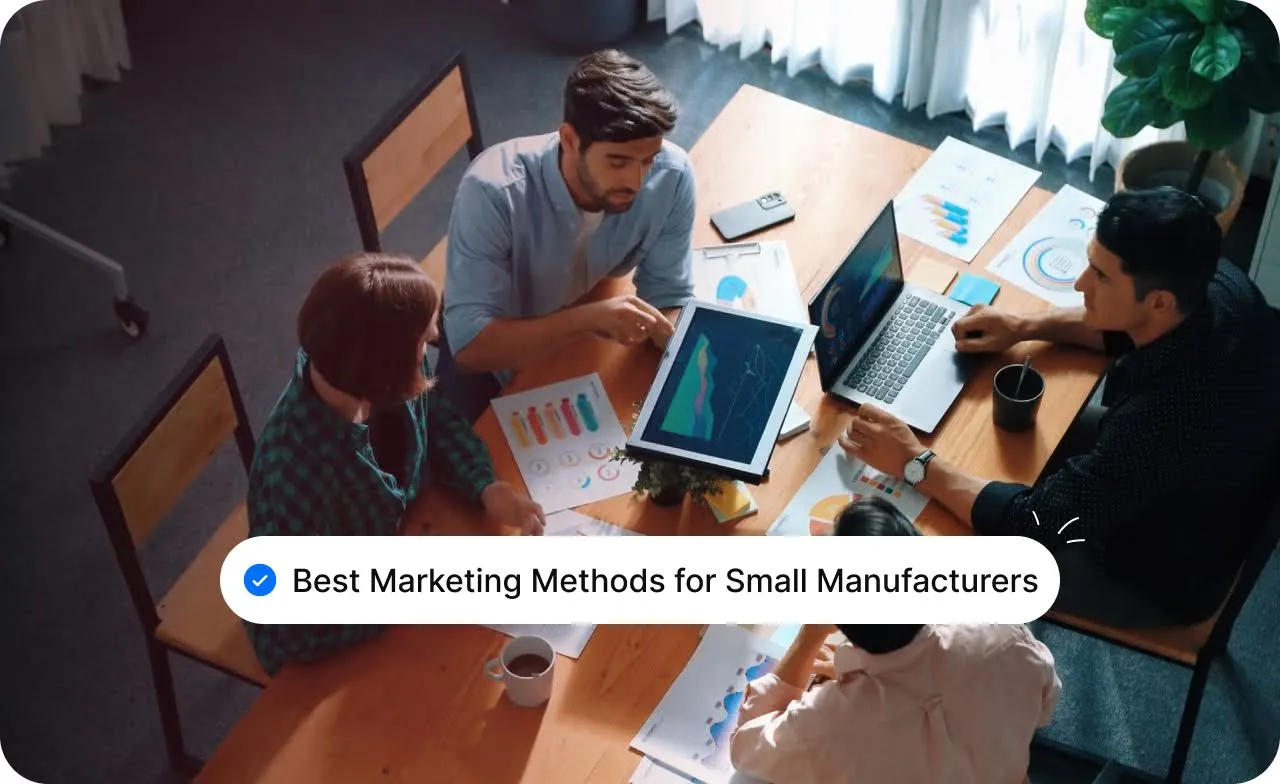
Small manufacturers live in a strange middle ground. You are not a startup. You are not a massive enterprise either. You run lean, stay hands-on, and juggle production, sales, and operations all at once. Marketing often ends up being the thing you get to only when everything else is done. And when you do touch it, it feels confusing, inconsistent, or impossible to measure.
Here is the part most small manufacturers overlook. You need more innovative methods that fit how your business actually runs. Simple systems. Clear positioning. Consistent visibility in the right places.
This blog breaks down 11 proven marketing strategies that help small manufacturers attract better leads, stay relevant, and create steady growth without burning time or budget.
Most marketing efforts fail for small manufacturers for one simple reason. The foundation is shaky. New tactics are added on top of unclear messaging, outdated websites, or inconsistent positioning. No strategy works well when the basics are misaligned.
Before you move into specific methods, make sure these core elements are solid:
Can a buyer understand what makes you different in under 10 seconds? If not, no strategy will convert well.
“Anyone who needs manufacturing” is not a target. Narrow focus makes every marketing move sharper.
A gallery of machinery is not enough. Buyers want context, process clarity, and real outcomes.
If it takes effort to request a quote or speak to someone, interest fades fast.
What you say on your website, emails, and sales material should reinforce the same story.
By implementing the right strategies and continually refining your approach, you can unlock meaningful growth.
Effective marketing for small manufacturers starts with clarity, consistency, and smart channel selection. From understanding who you are selling to and strengthening your online visibility, to building authority through content and nurturing long-term relationships, each strategy plays a role in creating steady demand:
Knowing your target market is the key to making your marketing efforts effective and efficient. If you're marketing to the wrong audience, even the best strategies will fall flat.
Actionable Steps:
Search Engine Optimization (SEO) is crucial for manufacturers aiming to boost their online visibility. With the right strategy, SEO doesn’t have to be complicated or costly.

Actionable Steps:
Content marketing is one of the most effective ways for small manufacturers to connect with potential customers by offering valuable, informative content that builds trust over time.
Actionable Steps:
Social media can be a powerful tool to engage with potential customers and showcase your products. The trick is to use the right platforms and content to make an impact.

Actionable Steps:
Email marketing is a highly cost-effective way to keep your brand in front of potential and existing customers. It’s an essential strategy for manufacturers who want to nurture long-term relationships.

Actionable Steps:
Pay-per-click (PPC) advertising is an excellent way for small manufacturers to drive targeted traffic quickly, especially in competitive markets where organic reach can take time.
Actionable Steps:
Referral programs are an easy and cost-effective way to acquire new customers by leveraging the trust your existing customers have in your products.
Actionable Steps:
Trade shows and industry events are excellent opportunities for manufacturers to network, showcase products, and build relationships with potential customers and partners.
Actionable Steps:
Also Read: Master the Art of Utilizing Content Marketing at Trade Shows: A Step-by-Step Guide
While influencer marketing is often associated with B2C businesses, it can be just as valuable for B2B manufacturers looking to expand their reach and credibility within the industry.
Actionable Steps:
Video marketing is a powerful tool to showcase your products in action, explain complex processes, and engage your audience in a dynamic way.
Actionable Steps:
The key to sustained success is constantly evaluating the effectiveness of your marketing strategies. Regular testing and adjustments help you stay ahead of the competition.
Actionable Steps:
Marketing for small manufacturers doesn't need to be costly or complex.
Remember, the real challenge is about attracting the right ones. SEO, content marketing, and targeted ads are key to building a foundation that drives lasting success.
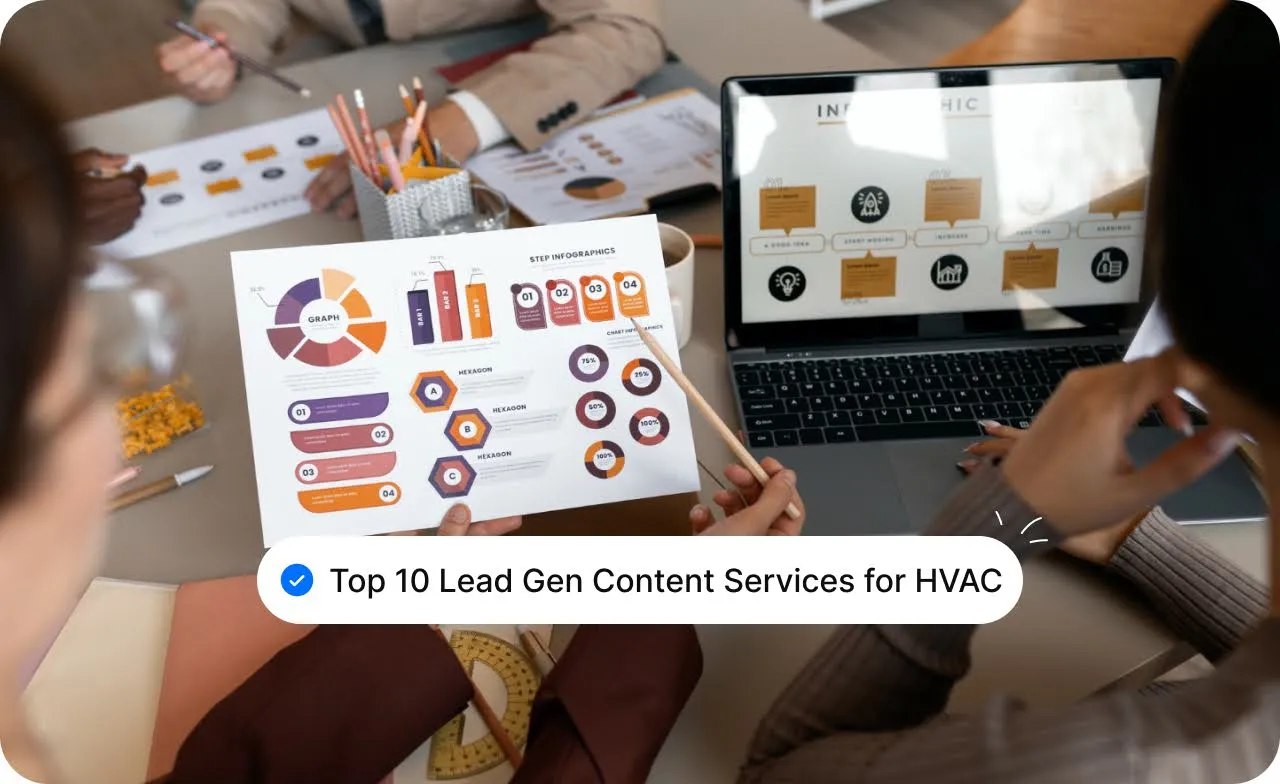
Most HVAC manufacturers are great at what happens inside the factory. You already know how to build reliable components, meet specs, and deliver on time. The real challenge shows up outside the factory walls when the people who need your products can’t clearly see what you offer.
Buyers rarely reach out unless they already understand your capabilities, your product range, and the value you bring. If that clarity is missing, they move on to the next option even if your solution is the better one.
That’s where content marketing becomes a practical method. This kind of marketing explains your products clearly, answers technical questions buyers already have, and helps serious prospects move closer to sending an inquiry.
In this blog, you’ll learn the top content marketing services for HVAC manufacturers that actually drive leads.
For HVAC manufacturers, content marketing is a practical way to solve real sales problems that slow business down.
Here’s why it matters:
HVAC components, systems, and parts often come with complex details. Good content breaks these details into simple, clear explanations that help buyers understand exactly what you make and whether it fits their project requirements.
When your content clearly lists capabilities, minimum order quantities, materials, and industries served, the wrong prospects stop reaching out. That saves your team time and brings in more serious, ready-to-buy leads.
Most HVAC manufacturers still rely on distributors, catalogs, and sales reps. But top-performing manufacturers now use online content to win attention earlier in the buying cycle.
When buyers see technical guides, case studies, product explanations, and clear processes, they feel confident about your capabilities. Trust doesn't come from your sales pitch. It comes from what buyers see online when they’re researching on their own.
Trade shows are valuable, but they’re seasonal and unpredictable. Content works all year, helping you get inquiries even during slow periods.
The services below focus on what actually moves the needle for B2B buyers: clear information, strong proof, and content that supports long sales cycles. Each one plays a different role in helping you get found, trusted, and contacted by the right decision-makers:

Gushwork specializes in AI-assisted SEO and lead generation systems tailored for HVAC manufacturers. Unlike traditional agencies, Gushwork takes a deep, data-driven approach to content marketing, focusing on long-term buyer journeys and ensuring every piece of content is optimized to capture high-quality, relevant leads.
Their suite of services including website development, CRM integration, automated marketing workflows, and targeted SEO & ads. It helps HVAC manufacturers create predictable lead flow and increase online visibility without relying on generic content strategies.
Gushwork’s exclusive focus on manufacturers gives them a unique understanding of the HVAC industry, allowing them to create highly targeted strategies that deliver measurable results.
If you want lead systems built specifically for HVAC manufacturers, Gushwork can help you attract better prospects and turn more of them into real opportunities.
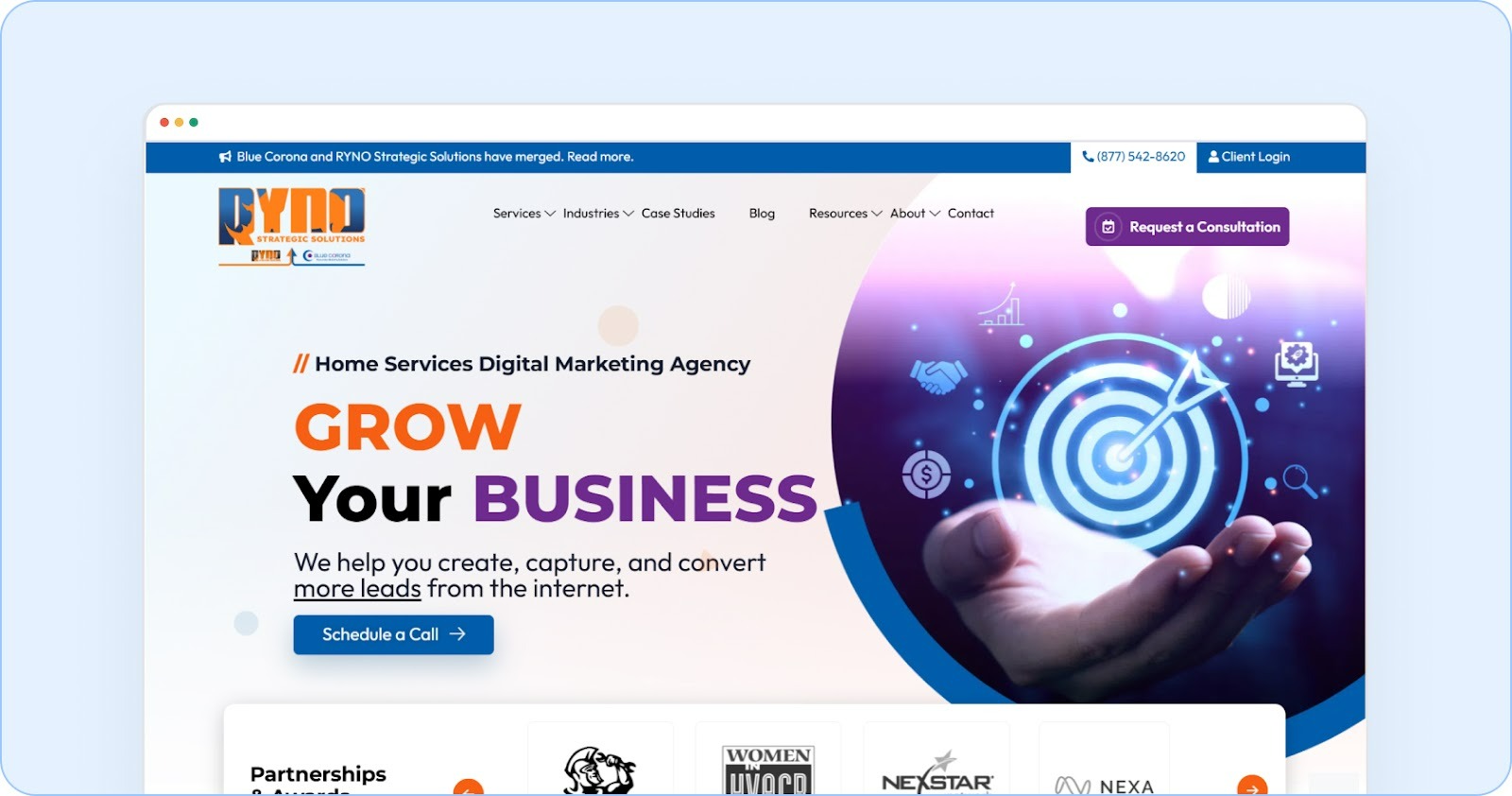
Best for: Full-service HVAC marketing with a focus on generating leads and increasing sales.
Blue Corona specializes in content marketing, SEO, and pay-per-click advertising for HVAC businesses. Their holistic approach helps HVAC manufacturers improve online visibility, attract leads, and optimize marketing costs.
Known for combining SEO, content creation, and PPC, Blue Corona offers a comprehensive solution to improve your HVAC company’s digital presence and lead generation.
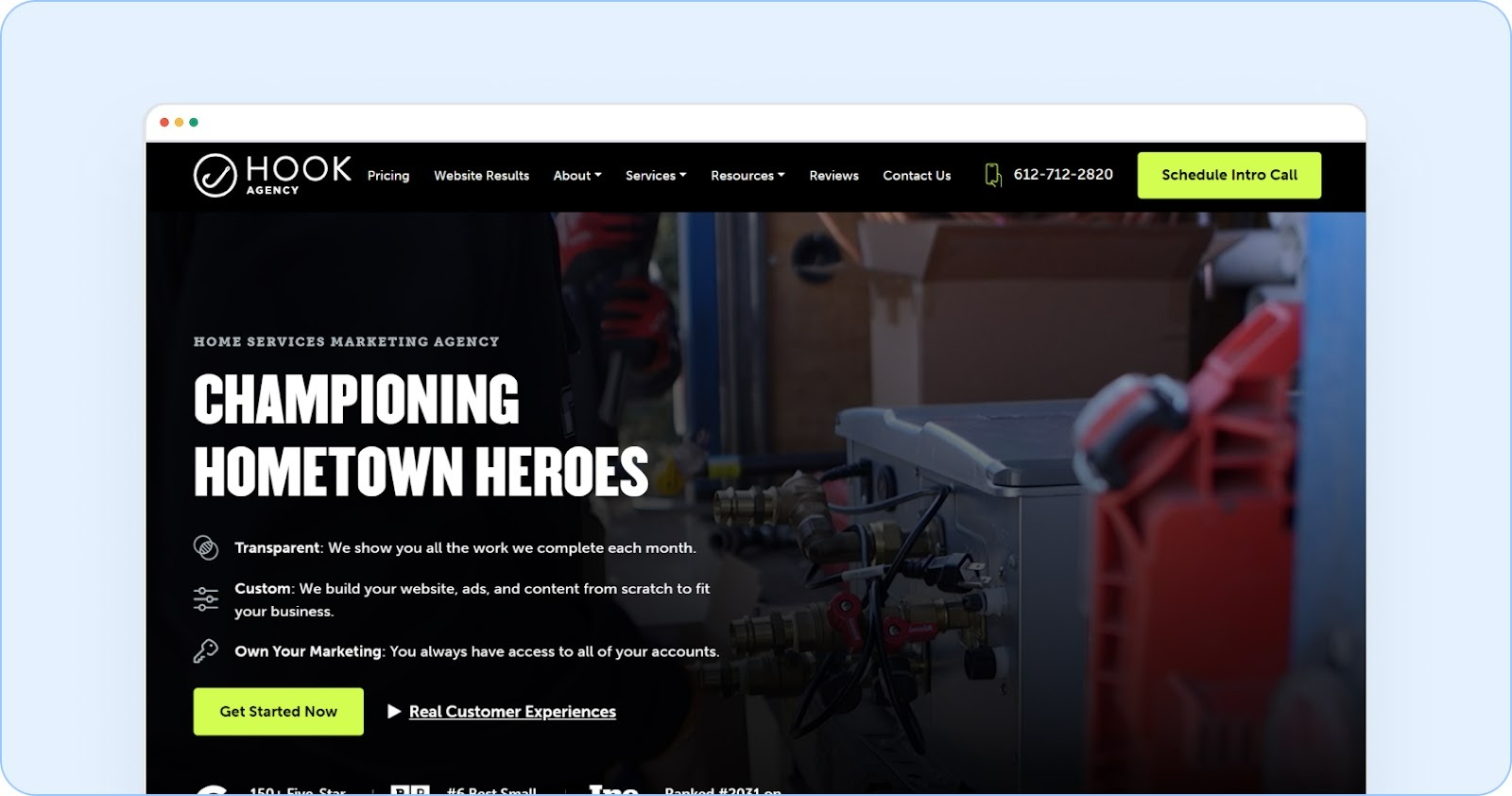
Best for: Tailored SEO and website strategies for HVAC companies.
Hook Agency specializes in building high-converting websites for HVAC businesses while providing SEO strategies designed to increase traffic and improve lead generation.
Hook Agency combines aesthetic website design with a focus on conversion, ensuring HVAC manufacturers not only attract visitors but also turn them into leads.
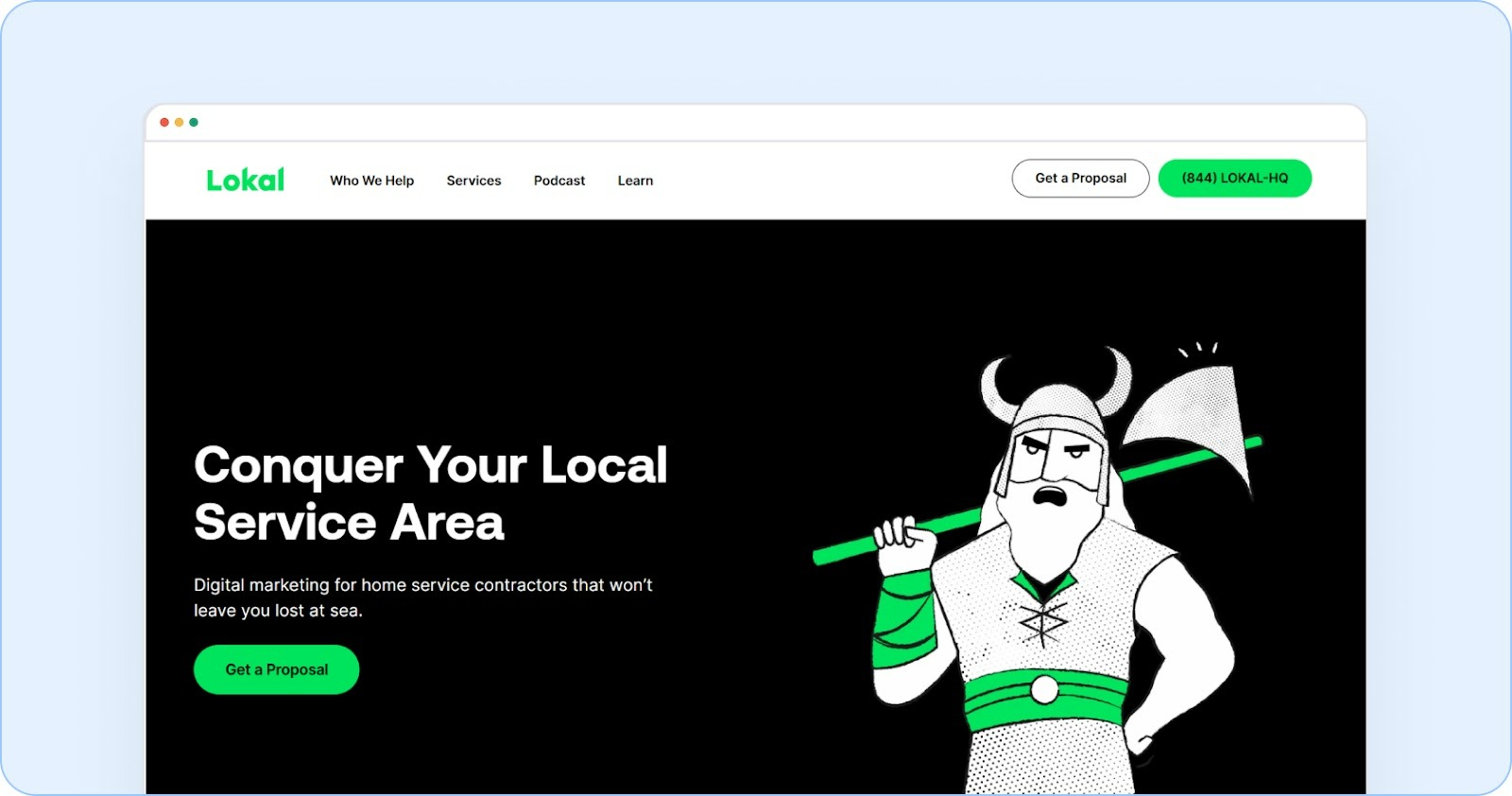
Best for: Data-driven, localized content marketing for HVAC companies.
Lokal offers personalized, data-driven marketing strategies that focus on local SEO and content creation, ensuring HVAC manufacturers target the right geographic market.
Lokal’s data-centric approach ensures HVAC manufacturers increase visibility in specific regions, driving highly-targeted local traffic.

Best for: Creative content marketing with a strong social media presence for HVAC brands.
Lemon Seed Marketing focuses on social media, content creation, and email marketing strategies designed to engage HVAC manufacturers' target audiences across platforms.
Lemon Seed excels at crafting engaging, creative content that resonates with HVAC brands’ audiences, driving both engagement and leads.

Best for: Comprehensive HVAC marketing with a focus on SEO and lead generation.
HVAC Webmasters offers a full suite of services, including content creation and SEO, designed to improve the online presence of HVAC manufacturers and generate qualified leads.
HVAC Webmasters is dedicated exclusively to HVAC businesses, creating tailored content strategies that drive measurable results for the industry.

Best for: Data-driven SEO and content strategies for HVAC companies.
Rival Digital specializes in creating custom content strategies for HVAC manufacturers, with a focus on SEO and increasing online visibility.
Rival Digital’s focus on data-driven content strategies helps HVAC manufacturers maximize SEO results and generate high-quality leads.
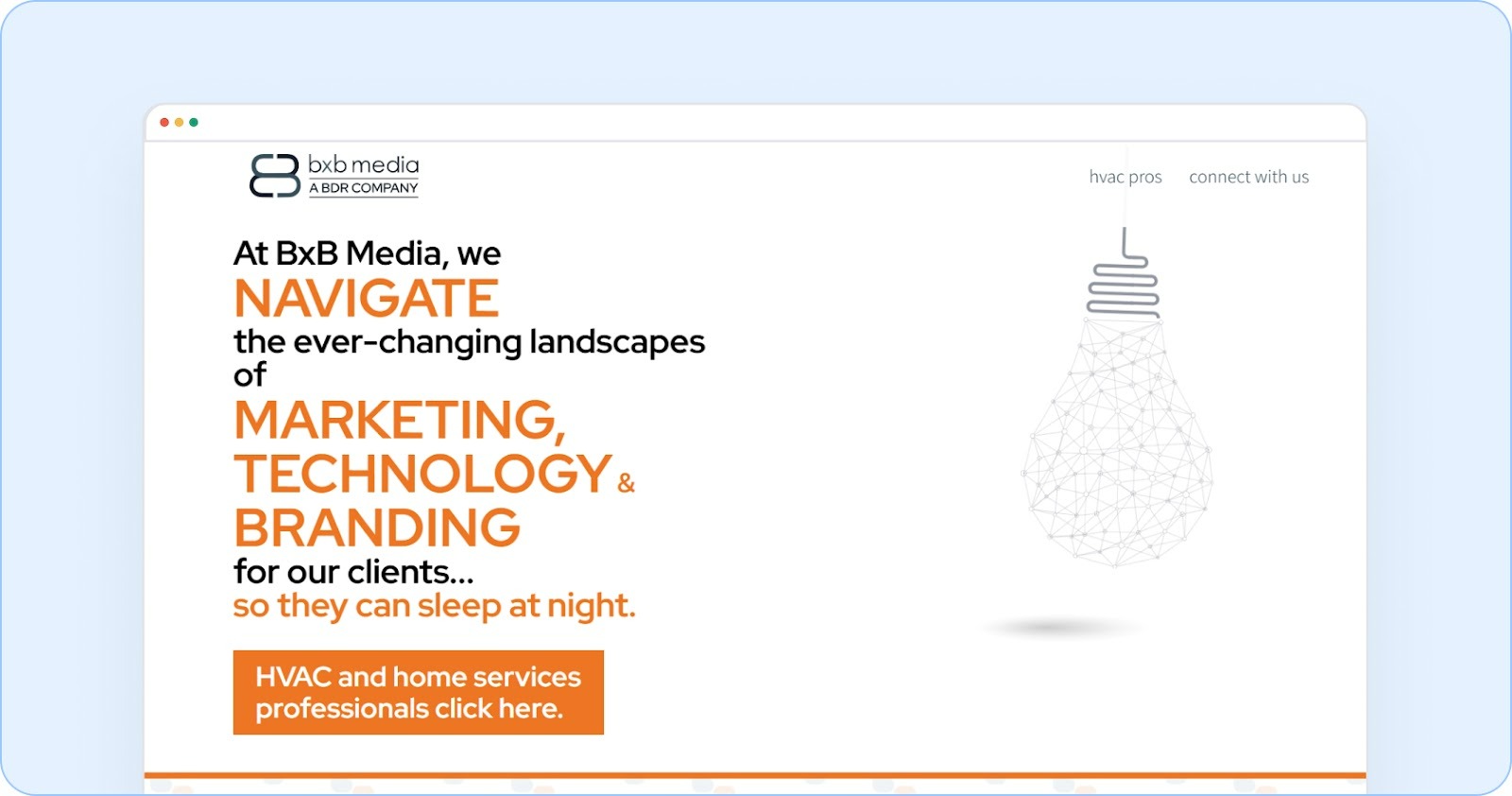
Best for: Blending traditional and digital marketing for HVAC businesses.
BXB Media offers a hybrid marketing strategy, combining both traditional and digital content marketing services to reach HVAC manufacturers’ audiences through multiple channels.
BXB Media’s unique approach bridges the gap between traditional and digital marketing, ensuring HVAC manufacturers can reach their audience on multiple platforms.

Best for: Comprehensive digital marketing with creative content services for HVAC brands.
1SEO Digital Agency offers content marketing, SEO, and creative services to help HVAC manufacturers enhance their digital presence and generate leads.
Their creative approach to content marketing and focus on visual storytelling help HVAC manufacturers capture attention and optimize for search.
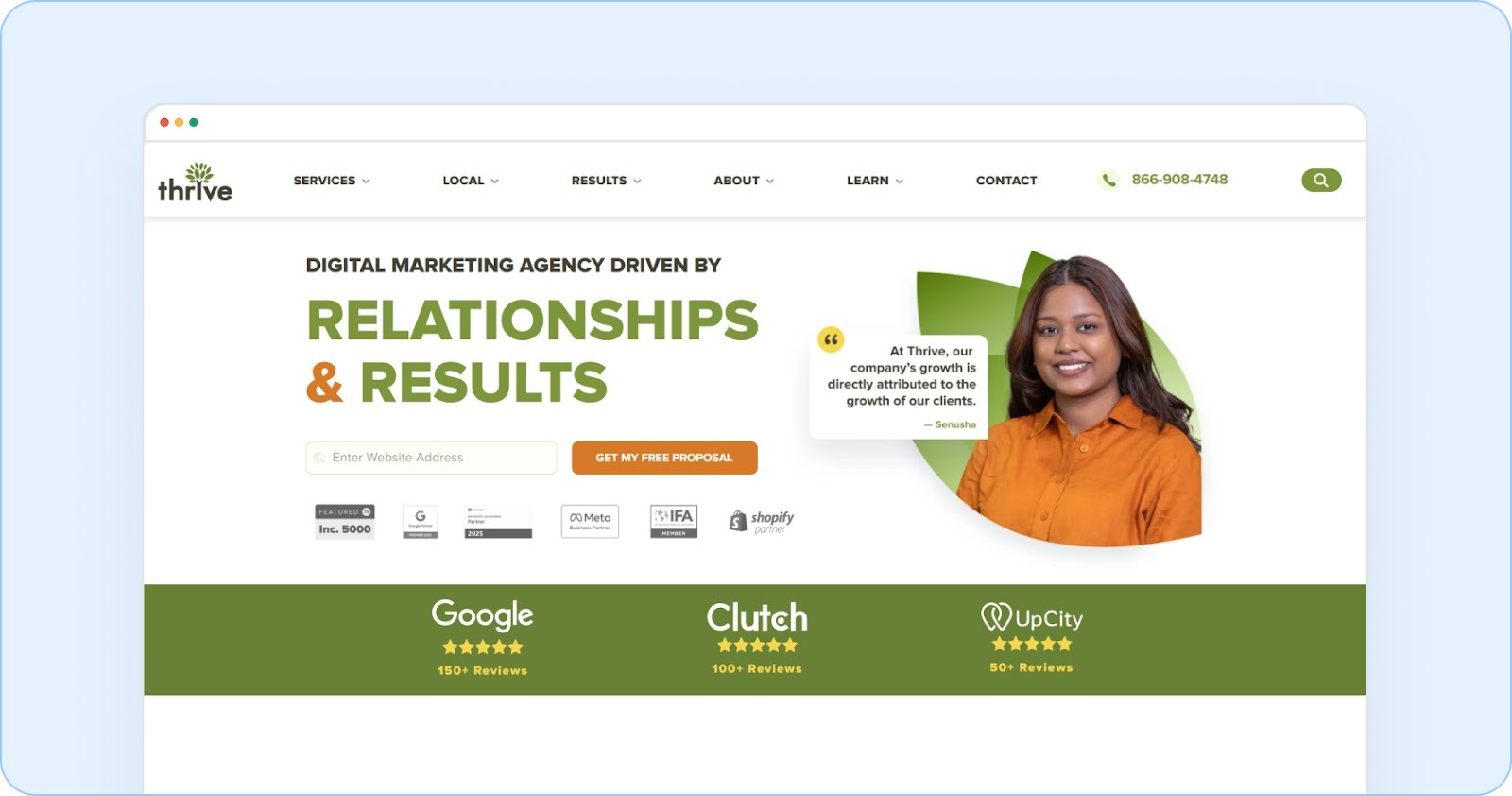
Best for: Full-service digital marketing for HVAC brands looking for end-to-end solutions.
Thrive Agency offers a comprehensive range of digital marketing services, including SEO, content marketing, and social media management, to help HVAC manufacturers succeed online.
Thrive’s end-to-end digital marketing services provide HVAC manufacturers with a one-stop solution for all their content marketing needs.
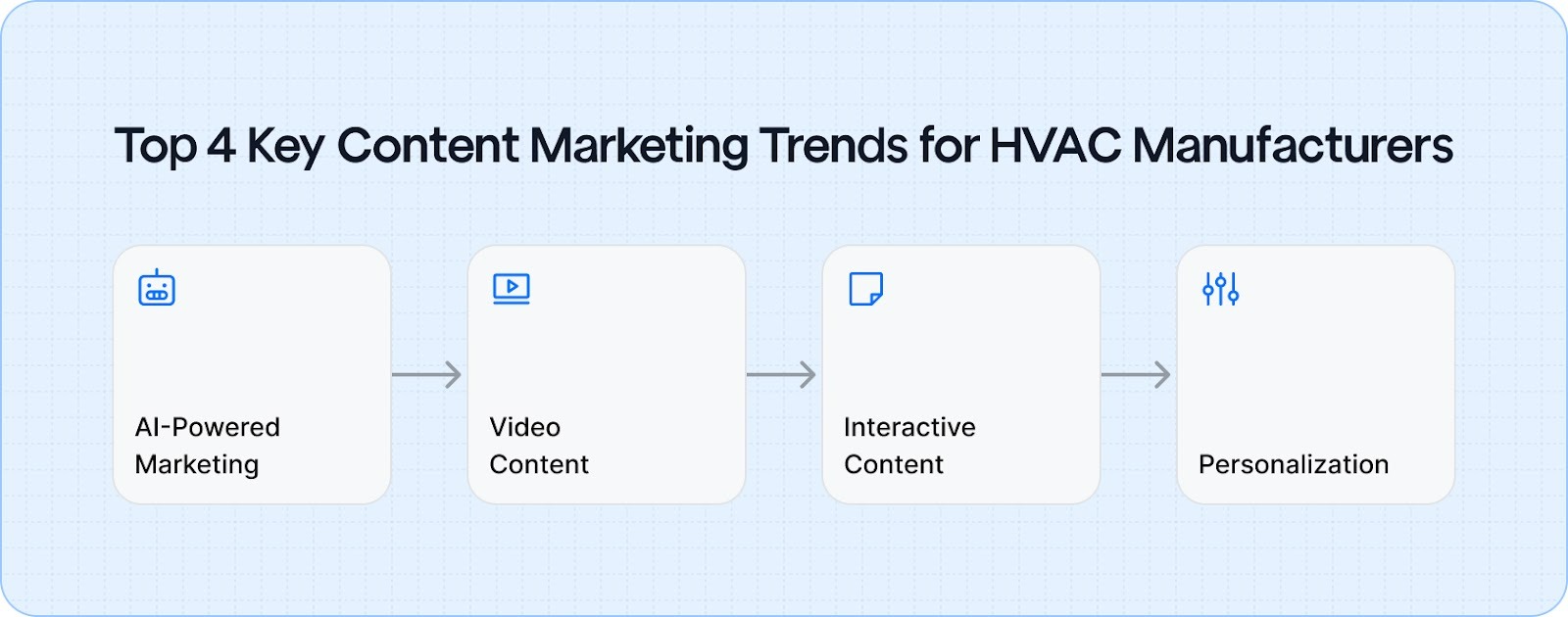
For HVAC manufacturers, keeping pace with evolving content marketing trends is crucial to staying competitive. With new technologies, shifting customer preferences, and increasing digital competition, HVAC companies need to adapt quickly to remain relevant.
Here’s a look at the specific trends HVAC manufacturers should focus on to enhance their content marketing efforts:
AI is no longer just a buzzword; it’s a key enabler of success in modern marketing strategies. HVAC manufacturers can leverage AI to optimize content creation, enhance SEO, and automate marketing workflows.
By incorporating AI into your marketing strategy, you can:
Incorporating AI into your HVAC marketing strategy empowers your company to stay ahead of competitors by creating content that not only attracts but also engages and converts your target audience.
Video is one of the most powerful forms of content in the digital age, and its popularity continues to grow. Short-form videos, in particular, have become a go-to medium for engaging potential customers. For HVAC manufacturers, here’s how video content can elevate your marketing:
Videos are compelling because they provide clear, visual explanations of how your products solve real-world problems.
For HVAC manufacturers, video can help simplify complex technical features, making them accessible to a wider audience.
Interactive content helps HVAC manufacturers actively engage their audience while collecting valuable insights.
Unlike static content, interactive tools foster participation, giving users a reason to engage with your brand. Here’s how to incorporate it into your marketing strategy:
Not only does interactive content increase engagement, but it also gathers valuable data, enabling HVAC manufacturers to segment their audience more effectively and personalize their marketing strategies.
In today’s competitive landscape, generic content doesn’t cut it anymore. Personalization is key to attracting the right prospects and driving conversions.
For HVAC manufacturers, this means creating content that speaks directly to the needs and pain points of your specific audience. Here’s how to personalize your content marketing efforts:
Personalized content can dramatically improve user engagement and conversion rates, especially when it speaks directly to your customers’ pain points and decision-making factors.
Also Read: Sales Enablement for Manufacturing: 5 No-Nonsense Ideas
Ranking on Google’s first page is a necessity for HVAC manufacturers looking to increase organic traffic and attract qualified leads.

While many factors contribute to SEO success, content marketing plays a crucial role in boosting search engine visibility.
Here’s how effective content marketing strategies can help HVAC manufacturers rank higher on Google.
To rank well on Google, HVAC manufacturers need to consistently produce content that is rich in industry-specific keywords. Here’s how to approach it:
By creating content around high-performing keywords, HVAC manufacturers can increase their chances of appearing in relevant searches, driving more targeted traffic to their site.
Content marketing extends beyond blogs and articles; it includes optimizing your product pages for search engines. HVAC manufacturers should ensure product pages include:
Optimizing your product pages with valuable content can improve both SEO rankings and the user experience, making it easier for potential customers to find the right products.
Google rewards websites that are linked to from other authoritative sites. This is where high-quality backlinks come in. HVAC manufacturers can improve their SEO by:
The more high-quality backlinks your website has, the more authority Google assigns to your content, improving your chances of ranking higher.
Google values websites that offer a seamless user experience (UX). To improve UX and boost SEO, HVAC manufacturers should focus on:
Providing a great UX not only benefits your visitors but also improves your SEO performance by keeping users on your site longer.
Content marketing is a vital tool for HVAC manufacturers who want to build lasting customer relationships and increase online visibility.
Simply relying on outdated marketing strategies won’t help you stay competitive. It’s time to shift from generic, one-size-fits-all approaches to highly targeted, AI-driven systems that focus on quality leads.
Key Takeaways:
If you're frustrated by low-quality leads and inefficiency, it’s time to optimize your marketing efforts.
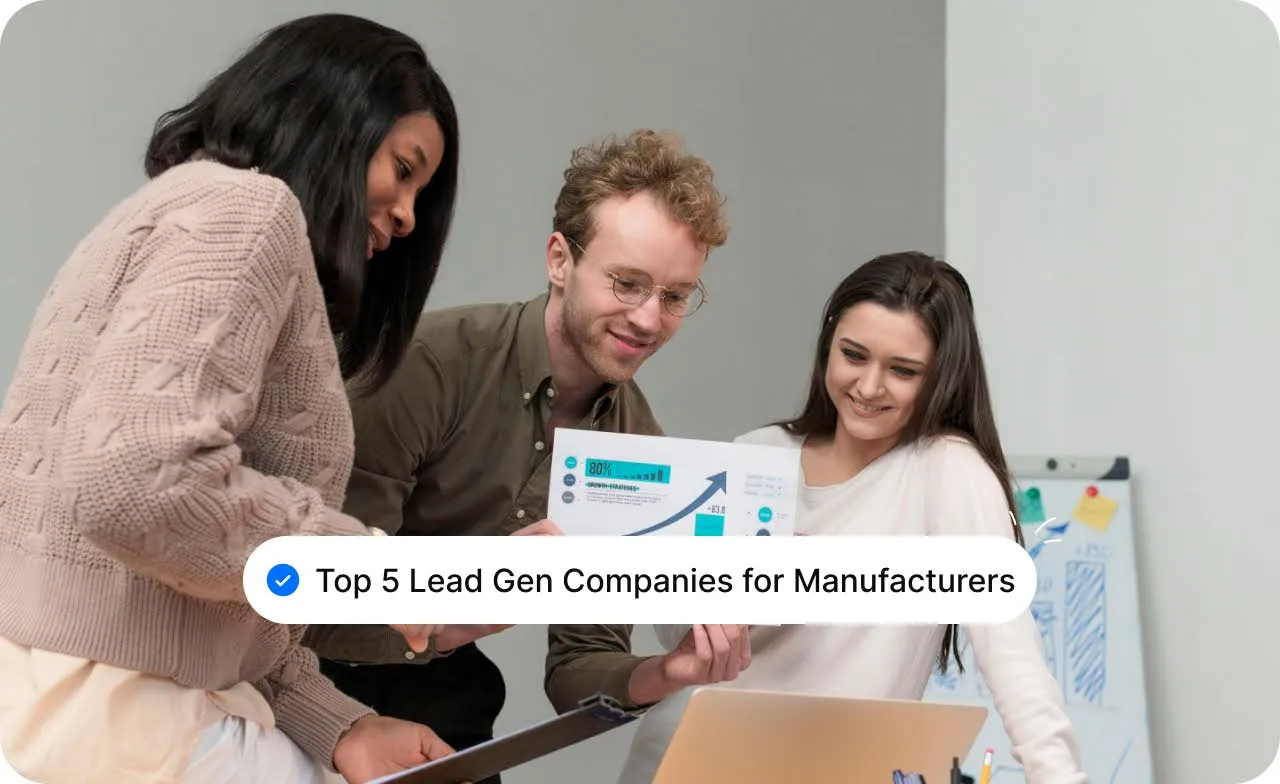
Most manufacturers don’t struggle with production. You already know how to deliver on specs, meet deadlines, and keep quality tight. The real struggle is getting in front of the right buyers who need exactly what you make.
That’s why many manufacturers look for support from lead generation partners who understand the industrial world.
In this blog, you’ll learn what lead generation companies actually do for manufacturers, why they matter, and the top five types you should consider if you want more qualified RFQs, better-fit prospects, and a steady sales pipeline.
Lead generation is the process of helping the right buyers find your business and getting them interested enough to talk to you. In manufacturing, a “lead” is usually someone who is a good fit for what you make, and wants to request a quote or start a conversation.
If marketing brings visibility, lead generation brings actual opportunities.
It’s the bridge between “someone is searching” and “someone is ready to speak to your sales team.”
Most manufacturing companies are built around operations, not marketing. So even if your product line is strong, the path that leads buyers to you is often unclear or inconsistent.
Here’s why a lead generation partner becomes valuable:
Procurement teams look online before they request a quote. They compare suppliers by capabilities, certifications, materials, and case studies. If your business doesn’t appear in those early searches, you’re out before the conversation even starts.
Most manufacturing teams run lean. Sales often doubles as customer service or account management. Outreach, follow-ups, and research can’t compete with day-to-day operations. A lead partner handles the top-of-funnel work your team doesn’t have the time or system for.
You might get messages from students, tiny buyers, or low-quantity requests. A good lead generation partner filters out noise so you spend time only on buyers who match your order size, materials, certification needs, and capabilities.
Many manufacturers lose opportunities because their online presence doesn’t show enough detail. Lead partners help package your capabilities in a way that’s easy for buyers to understand: clean data, clear specs, and focused messaging.
Trade shows, referrals, and repeat clients are helpful but inconsistent. Lead generation creates a steady flow of potential buyers that supports your sales goals throughout the year.
The companies listed below specialize in working with manufacturers, understand long sales cycles, and focus on leads that match your capabilities, production setup, and industry standards:

Gushwork offers a comprehensive lead generation system designed specifically for manufacturers. Integrating SEO, content marketing, CRM, and automation, Gushwork helps manufacturers focus on attracting high-quality leads who are already interested in what you offer.
Why It Matters?
Key Benefits:
If you want a scalable lead generation system built for the manufacturing industry, Gushwork is your way to lead efficiently.
Also Read: Manufacturing Lead Generation: A Complete Guide to Building Your Sales Pipeline
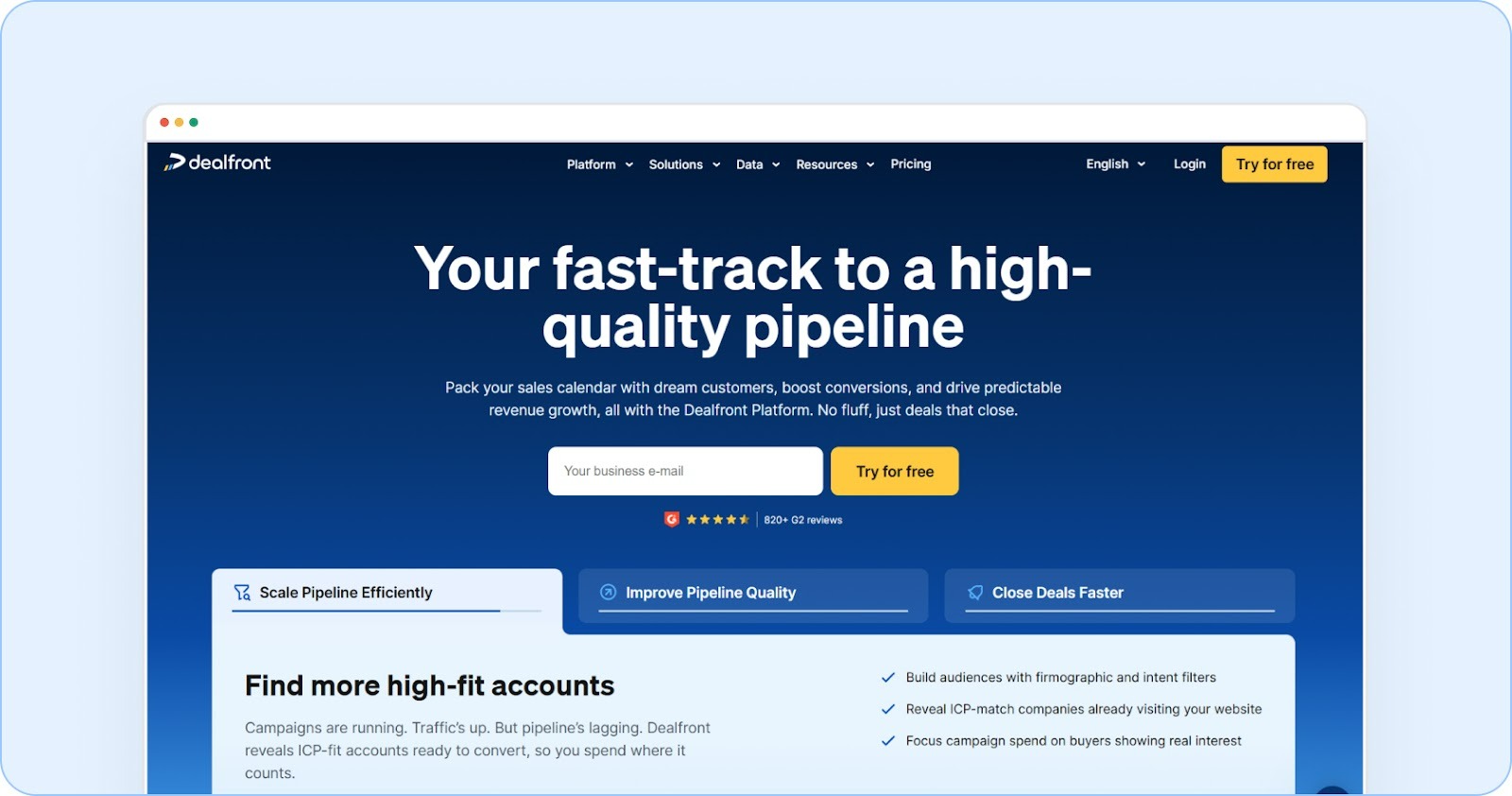
Why It Matters?
Key Features:
By identifying visitors that match your ideal customer profile, Dealfront helps manufacturers reduce wasted effort on unqualified leads and provides actionable insights into your existing web traffic.

CIENCE offers outsourced Sales Development Representative (SDR) teams that focus on lead generation using industry-specific databases. This solution allows manufacturers to scale their lead generation efforts without needing to hire or train an in-house team.
Why It Matters?
Key Benefits:
CIENCE’s outsourced SDR teams bring the expertise manufacturers need to generate and qualify leads effectively, enabling your business to grow without the operational hassle.

LinkedIn Sales Navigator is a powerful tool for manufacturers who need to target and connect with decision-makers within their industry. By utilizing advanced filters and real-time insights, LinkedIn makes it easier for you to engage with the right individuals responsible for purchasing decisions.
Why It Matters?
Key Features:
With LinkedIn Sales Navigator, manufacturers can streamline their lead generation efforts and ensure they are connecting with the right people, making it easier to close high-value deals.

Pearl Lemon Leads provides full-service lead generation with a personalized approach, focusing on appointment setting for manufacturers. Unlike traditional cold-calling services, they take the time to create tailored messaging that resonates with your target audience.
Why It Matters?
Key Benefits:
Pearl Lemon Leads offers a full-service approach to lead generation that ensures your sales team isn’t just talking to leads, but engaging with highly interested prospects ready to move forward.
Finding the right lead generation partner is crucial for manufacturers who want to scale effectively and target high-value prospects. But with so many options available, how do you choose the right one?
Here are the key factors to consider when picking a lead generation company that fits your business needs.
Before you start looking at companies, it’s essential to identify whether you need a full-service agency to handle the entire lead generation process or if you just need a software solution to complement your in-house efforts.
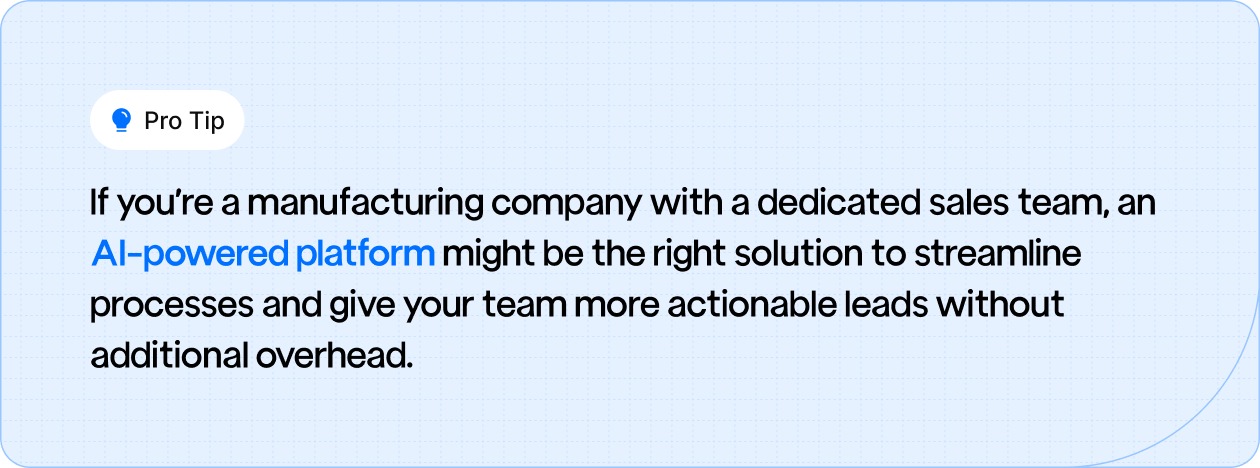
Not all lead generation companies understand the nuances of the manufacturing industry. When choosing a lead gen provider, look for one with experience in your industry.
A company that understands your specific needs and challenges will know how to tailor its strategies to attract the right decision-makers in your target market.
Key Questions to Ask:
A lead gen provider that has experience working with manufacturers will be better equipped to drive high-quality leads that fit your unique business needs.
Your business is likely to grow, and as it does, so will your lead generation needs. It's essential to choose a lead generation company that offers scalability and flexibility.
Choosing a company that can grow with you ensures long-term success and eliminates the need for a switch down the road.

While picking the right partner is essential, you can also take several steps internally to optimize your lead generation efforts. Here are some pro tips for maximizing your lead generation success:
Not all leads are created equal, and each type of buyer will have different needs. Tailoring your strategy to different buyer personas within your target industries is key to maximizing your lead generation success.
Segmentation ensures that your outreach is personalized and relevant, increasing your chances of conversion.
One of the biggest challenges manufacturers face is keeping track of all their leads and ensuring follow-ups happen at the right time. Automation tools can save you time and ensure that no leads slip through the cracks.
Automation ensures that you're engaging with your leads at the right time, increasing the likelihood of conversion while reducing the time spent on administrative tasks.
Also Read: PPC for Manufacturing: The Smart Way to Drive Leads and Slash Wasted Spend
The success of your lead generation efforts depends on continuously optimizing your strategy based on real-time performance. Use your lead generation tools to monitor key performance indicators (KPIs) such as:
By consistently monitoring your KPIs, you can adjust your strategy to focus on the channels and tactics that deliver the best results, ensuring that your lead generation efforts continue to improve.
Real-life examples provide powerful insights into the effectiveness of well-executed lead generation strategies. Here’s how two manufacturers transformed their businesses with targeted lead generation solutions.
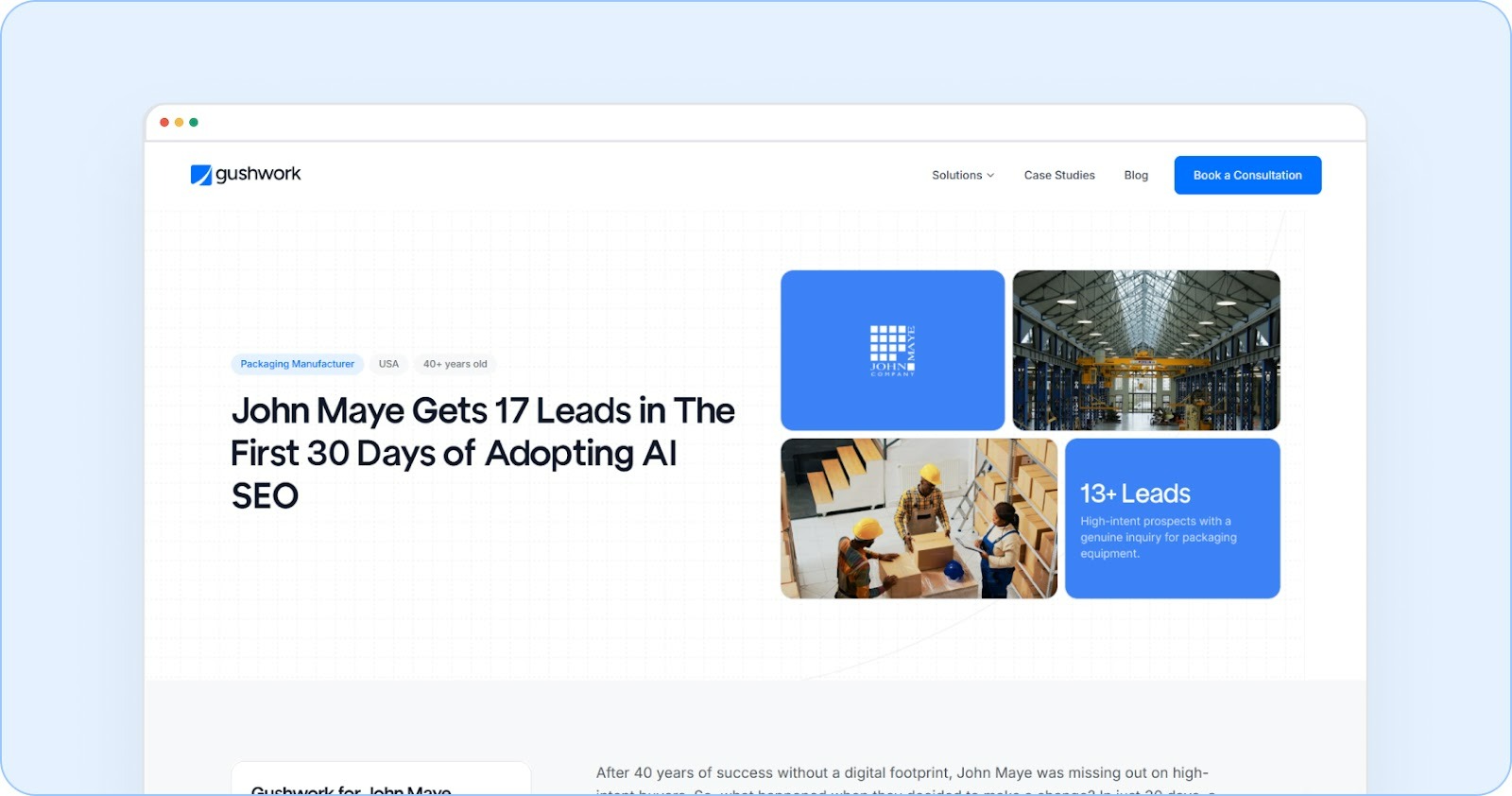
John Maye, a well-established name in the packaging equipment industry, had a problem; despite their long-standing expertise and trusted reputation, they lacked an online presence.
This meant they were missing out on qualified leads who were actively searching for their products online.
Their outdated website and reliance on traditional, cold outreach left them with low visibility in the digital space, and they weren’t able to engage with high-intent prospects.
John Maye partnered with a strategic AI-powered SEO strategy to elevate their digital presence. The goal was to improve organic visibility, capture qualified leads, and engage prospects who were actively searching for packaging solutions. Here’s what was done:
The Impact:
Key Takeaway:
The shift from traditional cold outreach to an AI-driven, SEO-focused strategy helped John Maye tap into a whole new pool of high-intent prospects.
The leads they generated were genuinely interested in their products, significantly reducing wasted time and resources on unqualified leads.

The Challenge:
Paniflex, a closet door distributor in the USA, faced a major issue: despite having a strong product offering, its visibility was virtually nonexistent online.
Buyers were actively searching for closet door solutions, but Paniflex’s website wasn’t showing up for the highly relevant keywords in search engines.
As a result, they were losing valuable business opportunities to competitors who had optimized their digital presence.
The Solution:
Paniflex made a strategic decision to optimize their website for high-intent keywords and focus on building their organic presence. Here’s what they implemented:
The Impact:
Key Takeaway:
Paniflex proved that you don’t need to spend a dime on ads to see remarkable results.
By focusing on organic SEO and creating valuable, search-optimized content, they were able to generate a consistent stream of qualified leads from buyers who were already looking for their exact solutions.
Lead generation is a critical component in growing your manufacturing business. Without the right strategy and support, it’s easy to waste time and resources chasing unqualified leads. But with the right approach, you can target and convert high-intent prospects who are genuinely interested in what you offer.
The solution isn’t in generic outreach, but in intelligent, AI-powered lead generation that’s tailored specifically for manufacturers like you. By partnering with the right company, you can streamline your processes and ensure consistent, high-quality leads for your business.
Q1. What is AI-powered lead generation, and why is it crucial for manufacturers?
A1. AI-powered lead generation uses artificial intelligence to target and engage high-intent prospects who are actively searching for your products.
For manufacturers, this means attracting businesses that truly understand your complex offerings, long sales cycles, and high-value contracts, while automating the tedious aspects of lead nurturing and follow-ups. This approach ensures efficiency and helps you focus on leads that are more likely to convert into valuable, long-term customers.
Q2. How can I measure the success of a lead generation strategy for my manufacturing business?
A2. The success of your lead generation strategy can be measured using key performance indicators (KPIs) such as the number of qualified leads generated, conversion rates, the quality of leads (determined by their fit for your business), and ROI (return on investment).
By tracking these metrics, you can refine your strategy to focus on the most productive channels and optimize your sales funnel for better results.
Q3. Can I integrate lead generation tools with my existing CRM system?
A3. Yes, many top lead generation platforms, including Gushwork, offer seamless CRM integrations. These integrations help you automatically capture, track, and follow up on leads directly within your CRM.
This eliminates manual entry, streamlines your workflow, and ensures that no leads slip through the cracks. It also ensures that all lead information is centralized for easy access and follow-up.
Q4. How do I choose between full-service lead generation companies and software solutions?
A4. If you need a comprehensive, hands-on approach, a full-service lead generation company might be the best option. These companies handle everything from research to outreach.
However, if you have an in-house sales team and only need a tool to enhance your efforts, a lead generation software that integrates with your CRM may be a more cost-effective solution. Consider your team's expertise, goals, and budget when deciding.
Q5. Can lead generation companies help with targeting decision-makers in my industry?
A5. Absolutely! Companies like LinkedIn Sales Navigator and Dealfront specialize in identifying and engaging decision-makers within your industry.
These tools enable you to narrow down prospects by job title, company size, and other filters, ensuring that you're connecting with the right people—key decision-makers who have the authority to make purchasing decisions.
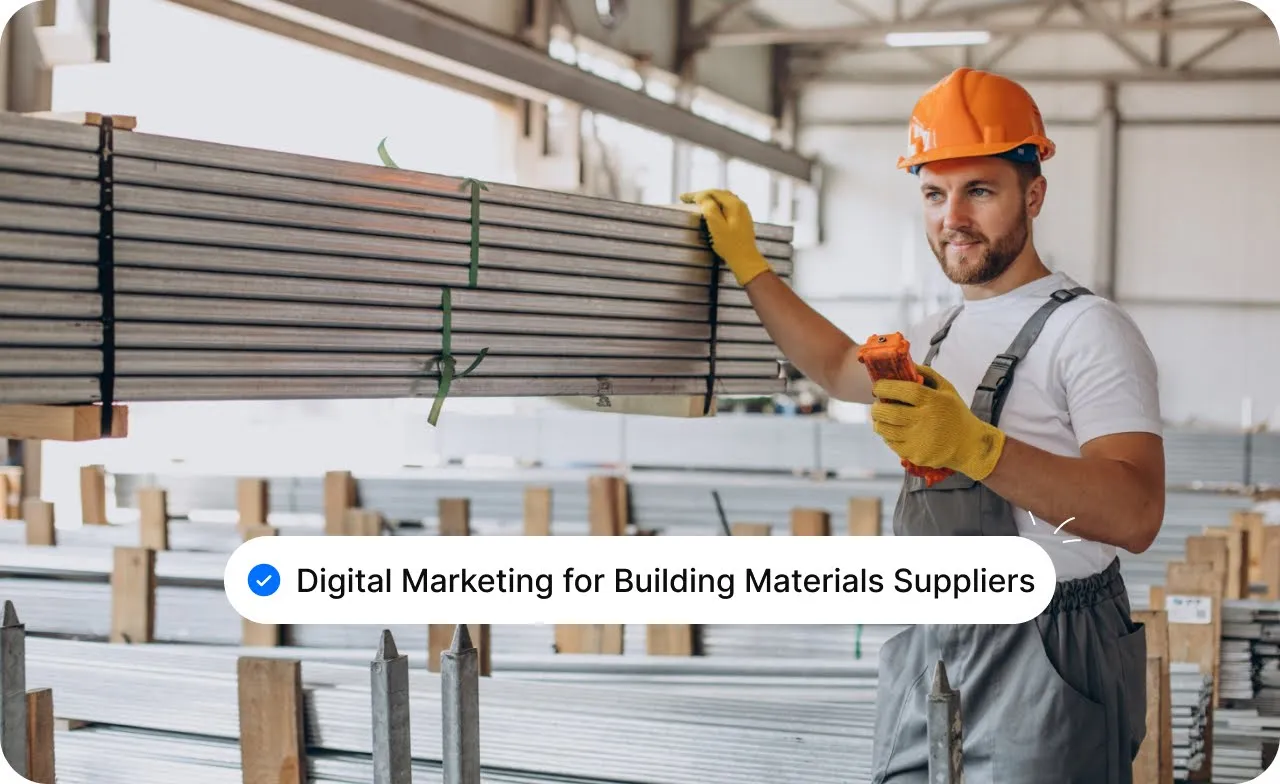
As a building material supplier, you know that attracting the right buyers is more than just generating traffic.

Contractors, architects, and dealers require specific, high-quality materials that meet their exact needs, and they often prioritize suppliers who understand the intricacies of their projects. Simply casting a wide net in your digital marketing can lead to wasted resources and missed opportunities.
This guide will show you how to fine-tune your marketing approach to target the right audience, those who are actively searching for materials like yours, helping you generate qualified leads that are more likely to convert into valuable business.
To stand out in the crowded building materials market, you need to speak directly to the key decision-makers who influence purchasing decisions.
Broad messages rarely work; instead, target your content to address the specific challenges faced by architects, contractors, and dealers.
Architects & Engineers: Architects and engineers look for materials that not only meet aesthetic and functional requirements but also reduce design risks. Their focus is on how your materials will integrate into their designs without compromising safety, sustainability, or compliance.
Highlighting BIM/Revit files, CSI 3-part specs, and certifications like UL demonstrates your understanding of their rigorous demands.
Contractors & Installers: Contractors are always looking for ways to save time and minimize complications on the jobsite.
Your marketing should offer install videos, failure-mode fixes, and calculators that help contractors work more efficiently and avoid costly mistakes during installation.
Dealers & Distributors: Dealers need to sell fast and keep inventory moving. Help them achieve this by offering co-op kits, co-branded landing pages, and lead routing solutions that attract and convert customers quickly. Providing these assets makes it easier for dealers to market your products and close sales.

Every buyer goes through a unique journey, and if you’re not engaging with them at each stage, they may slip through the cracks. From initial awareness to post-purchase loyalty, marketing at each stage of the funnel is crucial.
Top of the Funnel: At this early stage, prospects are still gathering information. Offering spec packs and detailed product descriptions helps introduce your materials and educates potential customers on their value.
This is the time to build awareness and trust.
Bid Phase: When prospects are ready to make purchasing decisions, they’ll want to know more about lead times, availability, and pricing.
Providing lead-time pages and value engineering (VE) guides addresses their concerns and helps them see how your products fit within their project timelines and budget.
For Existing Customers: Once a customer is on board, the goal is to keep them coming back. Offering reorder flows and reminders for regular maintenance or seasonal needs ensures they return for repeat purchases, strengthening customer loyalty.
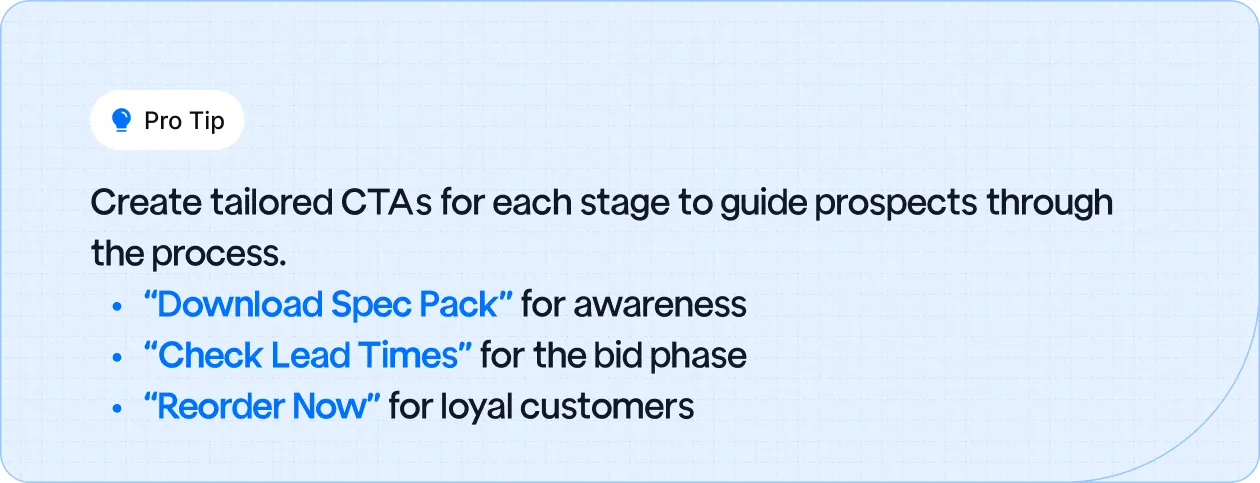
A website that simply showcases products won’t drive conversions on its own. To succeed, your website needs to capture leads, engage visitors, and ultimately convert them into paying customers.
As AI continues to shape search engine algorithms, your SEO strategy must evolve with it. Effective SEO for building material suppliers goes beyond basic keyword optimization; it involves technical SEO, local authority, and content that serves human needs.


Your content needs to do more than just inform; it should be a resource that helps your audience solve problems and make informed decisions.
BIM/Revit Families & Placement Guides: Architects use BIM/Revit families to integrate your products into their designs. Offering these resources, gated by role, ensures you target the right audience.

Each social media platform serves a different purpose when marketing building materials. Tailor your strategy to the strengths of each platform to maximize engagement.
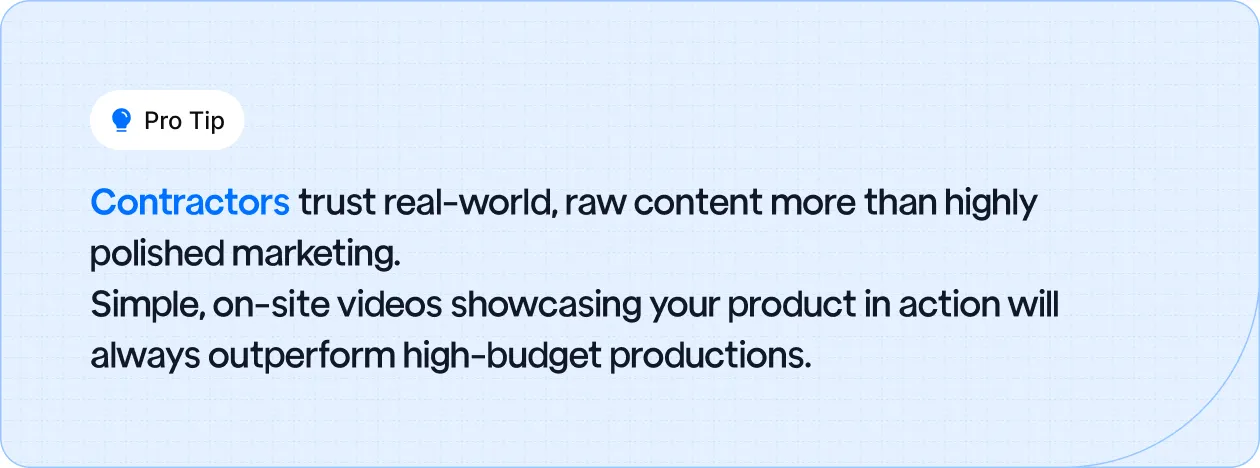
Paid advertising is one of the quickest ways to drive traffic to your website, but it’s only effective if you can track its impact on revenue.
Niche marketplaces offer specialized opportunities to reach qualified buyers. If you're not leveraging these platforms, you're missing out on significant exposure.

Email marketing should never be one-size-fits-all. For building material suppliers, a role-based approach to email nurture campaigns can dramatically improve engagement and conversions. Here’s how you can break it down for each key group:
The digital marketing landscape for building material suppliers requires a strong attribution model to ensure you’re measuring the right KPIs and making data-driven decisions.
Building material suppliers need to act quickly to stay competitive. This 90-day plan will ensure that your marketing strategy is in full gear and your products start moving faster.
Days 1-15:
Days 16-45:
Days 46-90:

Legal issues can cost your business time, money, and reputation. Ensure your marketing is compliant and clear to avoid any missteps.
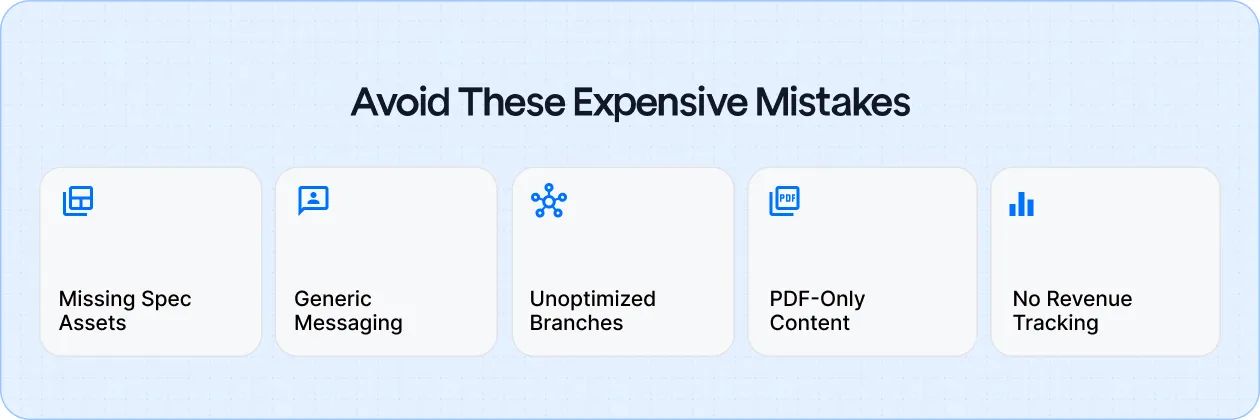
In building material marketing, small mistakes can quickly lead to missed opportunities and lost revenue. Here are the key mistakes to avoid:
Old playbooks, trade shows, brochures, and hope just won’t cut it anymore. The game has shifted; digital is where specs, bids, and reorders are won. It’s no longer about throwing everything at the wall and hoping something sticks.
You need a connected system that integrates SEO, ads, CRM, and spec-grade assets to fuel sustainable growth.
If you’re tired of wasting ad spend and generating unqualified leads, it's time to take control of your marketing and sales cycle. With Gushwork, manufacturers like you can harness a unified approach to drive better results at every stage, from spec generation to reorder.
Q1: How can I effectively use SEO to attract qualified leads for my building material business?
A1: Focus on long-tail keywords specific to your products and services, such as "fire-rated drywall suppliers in Chennai." Optimize your website with detailed product pages, downloadable spec sheets, and local SEO strategies to enhance visibility and attract targeted traffic.
Q2: What role does social media play in marketing building materials?
A2: Social media platforms like LinkedIn, Instagram, and Pinterest are valuable for showcasing your products, sharing case studies, and engaging with your audience. Tailor your content to each platform's strengths, professional insights on LinkedIn, visual project showcases on Instagram, and design inspiration on Pinterest, to build brand awareness and trust.
Q3: Is email marketing still relevant for building material suppliers?
A3: Yes, email marketing remains a powerful tool. Segment your audience by role, architects, contractors, and dealers, and send targeted content like product updates, installation guides, and reorder reminders. Personalized emails can nurture relationships and drive repeat business.
Q4: How do I measure the ROI of my digital marketing efforts?
A4: Implement a closed-loop attribution model by integrating your CRM with marketing automation tools. Track key performance indicators (KPIs) such as spec downloads, bids, purchase orders, and reorders. This data-driven approach helps assess the effectiveness of your campaigns and optimize strategies accordingly.
Q5: Should I invest in paid advertising for my building material business?
A5: Paid advertising can be effective when targeting specific keywords and demographics. Utilize platforms like Google Ads and LinkedIn to reach decision-makers. Ensure your ads are aligned with your audience's search intent and provide clear calls to action to maximize conversions.
Q6: How can I enhance my website to convert visitors into leads?
A6: Design your website with user experience in mind. Include detailed product descriptions, downloadable technical specifications, a dealer locator, and easy navigation. Implement clear calls to action, such as "Request a Quote" or "Download Spec Sheet," to guide visitors through the conversion process.

If you’re in the business of selling farming equipment, you already know the frustration: farmers aren’t Googling "tractor dealer" or "agriculture equipment."
They're searching for "low-hour John Deere 5075E near me" or "combine repair in [city]." Generic SEO won’t help you capture these hyper-specific, local, and detail-driven searches.

And if your equipment listings don’t show up for these precise queries, you're missing out on buyers who are ready to purchase today. This blog will focus on how SEO services can drive local traffic, optimize your inventory for search engines, and turn search results into qualified leads.
When it comes to farming equipment, most generic SEO advice misses the mark. Simply focusing on broad tactics like “publish more blogs” or “boost content quantity” does not address the unique needs of the farming industry.
Farmers are searching for specific equipment models, part numbers, and local services, not general dealership listings. If your SEO strategy doesn’t cater to these specific queries, it won’t generate the qualified traffic your business needs to close sales.
Farming equipment buyers typically look for highly detailed information such as equipment hours, make/model specifics, and local availability. Without addressing these critical elements in your SEO, your business may fail to appear in the right search results when potential customers are ready to buy.
For farming equipment businesses, it’s not just about having product listings online; it’s about optimizing those listings for search engines so they can be easily found by farmers actively searching for the equipment you sell.

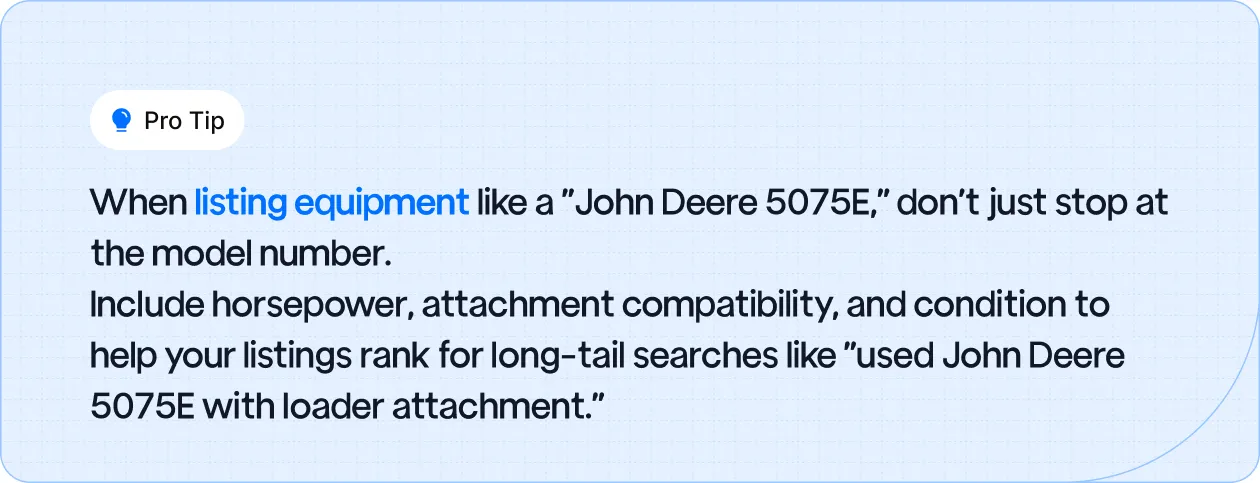
For farming equipment businesses, local search is the key to attracting customers who are searching for equipment in their immediate area. Farmers prefer to buy equipment from nearby dealerships to avoid long shipping times and costs.
This is why local SEO is a must for your business.

Also Read: SEO for Industrial Companies: Why Your Customers Can't Find You
While selling equipment is important, service and parts sales often provide steady, recurring revenue. Many farming businesses overlook the SEO potential of their parts and service pages, but these can be powerful assets for driving traffic and capturing leads.

Content marketing for farming equipment businesses needs to go beyond generic product descriptions. Farmers want content that addresses their challenges, whether it’s fixing a mechanical issue, finding the right equipment, or getting ready for a season.
To stand out in a competitive market, you need to build your authority in the agricultural industry. This means positioning your business as a trusted resource for both information and services.

Marketplaces like TractorHouse, AgDealer, and MachineryTrader are excellent platforms for showcasing farm equipment, but they shouldn’t be your only source of leads. Funneling traffic back to your own website should always be part of your strategy.
Must Read: PPC for Manufacturing: The Smart Way to Drive Leads and Slash Wasted Spend
It’s not enough to just track rankings or traffic; you need to measure real-world business impact. How many of the people visiting your site are converting into qualified leads or actual sales? Here's how to track and measure your SEO ROI.

Also Read: How Manufacturers Can Win More Leads With SEO
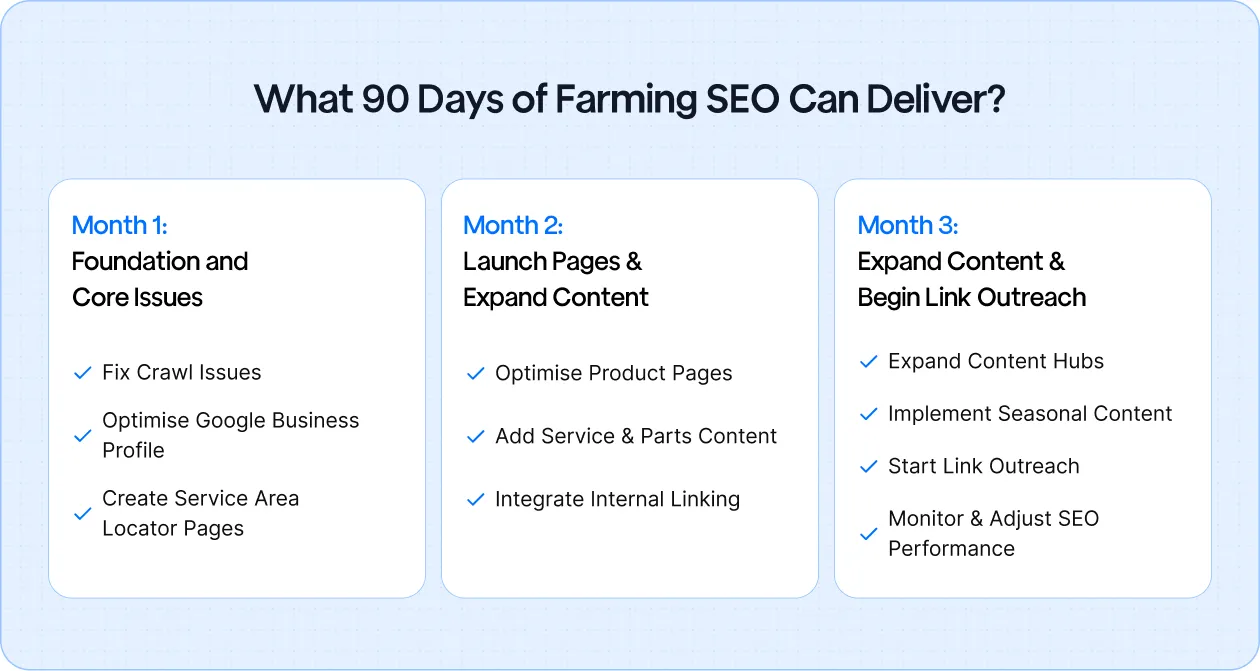
A well-structured SEO strategy for farming equipment businesses can deliver tangible results in as little as three months. By focusing on high-impact actions in the first 90 days, you’ll see improvements in search rankings, traffic, and lead generation. Here's what to expect in your first 90 days:
The first month is about establishing a strong SEO foundation. It’s crucial to address any technical SEO issues and optimise for local search, a key factor in farming equipment SEO.
Key Actions in Month 1:
![An optimised GBP will help you appear when farmers search for "farm equipment near me" or "tractor repairs in [location]".](https://cdn.prod.website-files.com/6614dca1d3aa7b076d6f3004/68d3c44c6a5eeb3b9516d1bf_346540ca.webp)
By the second month, you’ll have established the foundation. Now, it’s time to focus on optimising your product pages and expanding content to target more specific search queries.
Key Actions in Month 2:

The third month focuses on scaling up and diversifying your content to reach a broader audience. Now it’s time to build authority with targeted seasonal content and link-building strategies.
Key Actions in Month 3:

By the end of the 90-day period, you should start seeing improved local rankings, increased organic traffic, and higher-quality leads. However, SEO is an ongoing process.
The next phase involves building on your progress by refining your strategy, scaling content efforts, and continuously improving on-page and off-page SEO for sustained growth.
Your SEO strategy should be tailored to your business model. Whether you’re a single-store dealership or an OEM distributor, your SEO needs will vary. Here’s how to structure your SEO packages to suit different business types.

For farming equipment businesses, SEO isn't just about gaining traffic; it’s about moving equipment, selling parts, and filling service bays. Companies that focus on local SEO, targeted product listings, and seasonal content will be the ones farmers find first when they need equipment, parts, or repairs.
The reality is that a DIY approach to SEO won’t be enough to keep up with the competition. To succeed, you need a strategic, comprehensive SEO plan tailored to the unique needs of farming equipment sales and services.
A1. Local SEO is critical because most farming equipment buyers prefer to purchase from nearby dealerships to avoid shipping costs and long delivery times. Optimizing for local search ensures your business shows up when farmers are searching for equipment or services in your area, increasing the likelihood of conversion.
A2. Optimise your product pages by including detailed descriptions, make/model, condition, attachments, and hours of use. Use schema markup for structured data to help search engines understand the specific details. Don't forget to include location-based keywords and long-tail keywords for better visibility.
A3. Create category hubs that focus on different types of equipment (tractors, sprayers, combines), offer seasonal content (e.g., pre-harvest checklists), and produce problem-solving videos or troubleshooting guides. Farmers often search for specific solutions, so content that answers their questions directly will help boost engagement and traffic.
A4. To improve your Google Business Profile, ensure that all information is complete and accurate, including hours of operation, services, and location. Add high-quality photos, encourage customers to leave reviews, and regularly update the profile with new content. An optimised GBP helps you appear in the local map pack and boosts your local search visibility.
A5. Link-building from reputable sources like agriculture blogs, extension services, and local media outlets helps increase your site's credibility and domain authority, which are crucial for ranking higher in search results. High-quality backlinks from relevant sites signal to search engines that your content is authoritative and trustworthy.
A6. SEO for farming equipment businesses can start showing results in as little as 90 days. By focusing on technical SEO, local search optimisation, content creation, and link-building strategies, you can improve your visibility, traffic, and lead generation in the short term. However, continuous SEO efforts are necessary for long-term success.
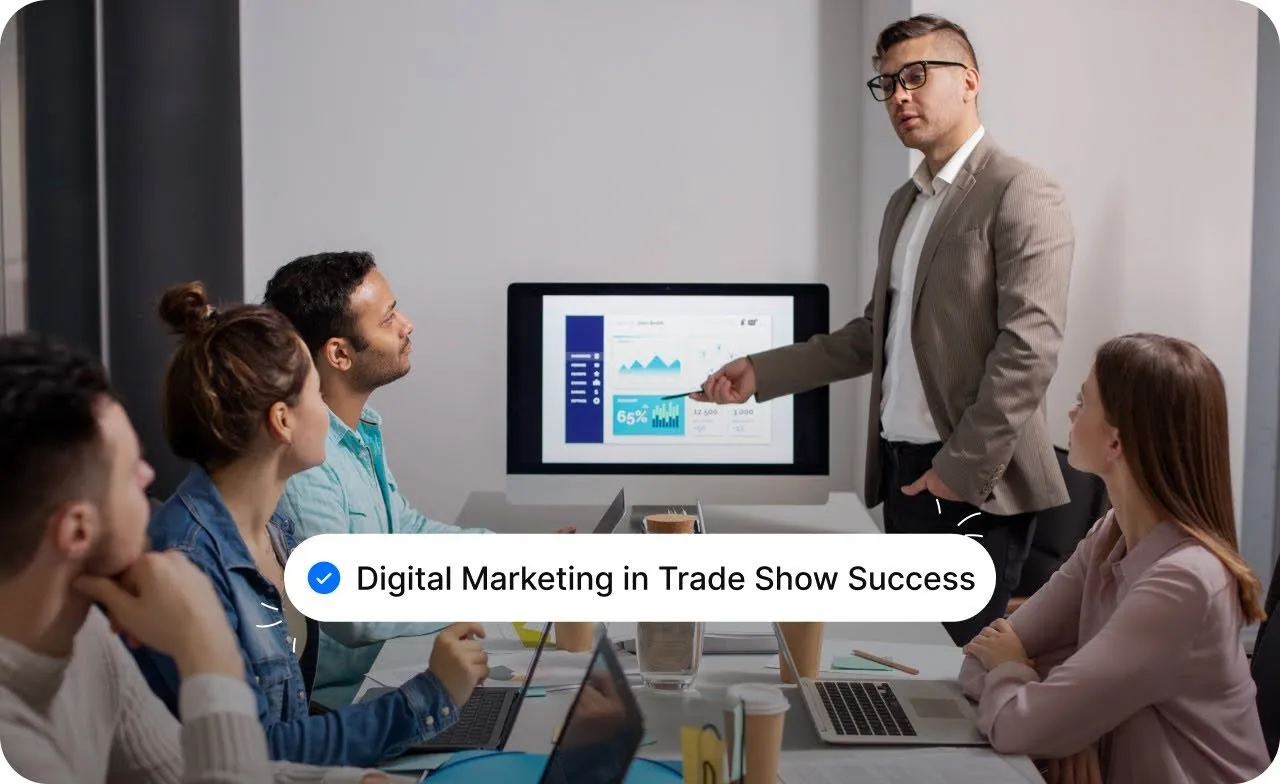
Are you tired of watching your trade show investment disappear into the noise of thousands of exhibitors? Your booth might be attracting visitors, but how many of them are genuinely interested in what you offer?
The reality is, without a digital strategy, your trade show presence risks being just another display in the background, overshadowed by competitors who know how to leverage digital tools to connect with high-value prospects.
The problem isn't your booth setup or product; it’s that in today’s digital-first world, simply showing up isn’t enough. Without the right digital marketing strategy, you’re not just missing out on a few leads; you’re leaving a ton of potential on the table.
This article isn't about generic traffic; it’s about showing you how digital marketing can take your trade show experience from a one-off interaction to an ongoing conversation with the right buyers, long after the event ends.

Digital marketing is the backbone of modern trade show success, optimizing every touchpoint and maximizing ROI. It ensures you attract the right audience, engage them before and after the event, and measure results effectively.
Digital marketing ties everything together, before, during, and after the event, ensuring your trade show presence generates ongoing value.
Digital marketing is no longer an optional tool for trade show success; it's the key to transforming a one-time event into a year-long opportunity. Without it, your booth can easily become just another display, unnoticed and underperforming in a sea of competitors. Missing digital marketing means you're not leveraging the full potential of your trade show presence.

Without digital marketing, you're invisible to your target audience before the event starts, reducing the chance of attracting high-value leads.
Digital marketing pre-warms the audience, building anticipation through emails, targeted ads, and social media, so when the event starts, they are already familiar with you.
Digital marketing allows you to pre-qualify and engage these prospects early, ensuring your booth attracts those who matter most.

Digital marketing turns your booth into an active hub of engagement, where real-time updates, posts, and interactions drive foot traffic.
Digital marketing creates shareable moments that amplify your presence and encourage visitors to keep talking about your brand long after they leave.
Digital marketing gives you real-time analytics, allowing you to adjust your approach on the fly and capture valuable insights for follow-up.
For a deeper dive into actionable pre-show, during-show, and post-show strategies, check out our dedicated blog here.

Digital marketing helps you stay engaged with attendees, turning initial interest into real business.
Without it, the connection fizzles out within a few days.
Digital marketing enables you to track leads, measure engagement, and calculate ROI, giving you the insights to optimize future trade show strategies.

Digital marketing doesn’t just add to your trade show presence; it multiplies its impact. For the same investment in a booth, you can expand your reach, engage attendees longer, and increase the quality of leads.

These three pillars, Pre-Show, During-Show, and Post-Show, ensure your trade show strategy is optimized at every step. Missing any of them leaves significant opportunities on the table.
Digital-first exhibitors see clear advantages in booth traffic, lead conversion, and overall ROI. Companies that don't embrace digital marketing risk falling behind in every aspect of their trade show performance.





Digital marketing allows you to track and measure the impact of every action, helping you justify your investment and continuously improve your trade show strategy.
Digital marketing isn’t just a tool for today; it’s the future of trade show success. As technology evolves, digital strategies will continue to reshape how trade shows are executed.

Digital marketing isn’t just an optional addition to your trade show strategy; it’s the core foundation that determines your event's success or failure. Without it, you risk being invisible in a sea of competitors.
The reality is simple: your trade show investment is only as strong as the digital strategy that supports it. Without a digital approach, you’re not only missing out on valuable engagement; you're leaving your ROI on the table.
Q1. How can digital marketing help attract the right audience to my trade show booth?
A1. Digital marketing allows you to pre-target high-value prospects before the event. By using SEO, social media ads, and email campaigns, you can ensure your booth attracts qualified leads who are already aware of your brand and offerings.
Q2. What are the best digital marketing strategies to use before a trade show?
A2. Focus on building anticipation and awareness through social media teasers, targeted ads, email campaigns, and SEO-optimized landing pages for your booth. These strategies help ensure that the right audience is aware of your presence before the event.
Q3. How can digital marketing increase engagement during a trade show?
A3. Digital marketing enhances booth engagement through live social media updates, real-time lead capture, and interactive digital content. These efforts amplify your presence, drive foot traffic, and expand your reach beyond the physical event.
Q4. What role does data play in post-show follow-up with leads
A4. Data-driven insights allow you to personalize follow-ups based on attendee behavior. By tracking which products they showed interest in and what content they engaged with, you can tailor your emails and offers, significantly increasing your chances of conversion.
Q5. How do I measure the effectiveness of my trade show digital marketing strategy?
A5. Key performance indicators (KPIs) like email open rates, landing page visits, booth traffic, lead capture, and follow-up response rates help track the effectiveness of your digital marketing. Measuring these metrics ensures that your trade show investment is paying off and provides insights for optimization.
Q6. Can digital marketing strategies extend the value of my trade show participation beyond the event?
A6. Yes, digital marketing allows you to nurture relationships post-event through retargeting ads, follow-up emails, and ongoing social media engagement. These strategies ensure that you continue to connect with leads, turning short-term interactions into long-term business relationships.
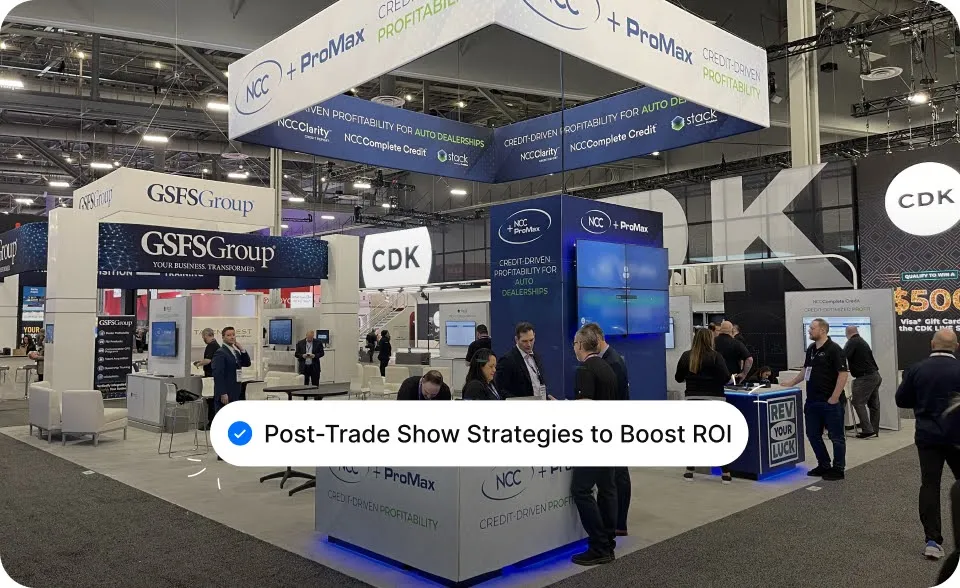
You’ve spent weeks preparing for your trade show, fine-tuning your booth, your pitch, and your team. But now the event is over, and your biggest challenge is making sure all those leads don't fizzle out.
The truth is, most manufacturers fail to capitalize on their trade show success because they don’t have a clear, actionable post-trade show marketing strategy. Without a well-defined follow-up plan, all those promising conversations and new contacts will likely get lost in the shuffle.
If you're wondering how to avoid this costly mistake and turn those leads into real business, you're in the right place. This guide will walk you through proven post-trade show marketing strategies that ensure your hard work pays off long after the event ends.
After the trade show excitement fades, the window of opportunity to connect with your leads is narrow.
Speed is crucial. Research shows that leads contacted within 24 hours are 60% more likely to convert. The faster you reach out, the more likely you’ll stay top-of-mind.
Why Fast Follow-Up Works?
The clock is ticking once the event ends. Immediate follow-up demonstrates urgency and commitment to solving your leads' problems.
It also keeps the positive interaction fresh in their minds, reducing the chance of them forgetting about you as other post-show content floods their inbox.

Visuals help reinforce your connection and make your email stand out in a crowded inbox.
Sending out a generic "nice to meet you" email is a quick way to lose engagement. Your leads expect personalized, relevant communication, not an unimaginative email. After an energetic trade show, they want to feel like they are more than just another name on your list.
Why Personalization Works?
Generic emails are easily ignored. Personalization, on the other hand, increases engagement by 29%. By tailoring your message, you show that you remember their specific needs, challenges, and the conversations you had at the show.
This approach keeps them engaged and enhances your credibility.
When you’re trying to convert leads into customers, it’s crucial to understand where they are in their decision-making process. The key is to adjust your messaging depending on how “warm” or “cold” they are. This helps you stay relevant to their needs and increases the chances of closing the deal.
Subject: Great to Connect at [Event Name] – Let’s Take the Next Step
Hi [Lead Name],
It was great meeting you at [Event Name]! I enjoyed discussing [specific topic] and wanted to follow up to see how [product/service] could help address [specific pain point].
I’d love to schedule a call to explore how we can [solution benefit]. Let me know your availability!
Best regards,
[Your Name]
When you return from a trade show, you’ll have hundreds of leads to manage. Staying organized is crucial, and a CRM tool is your best friend for tracking and converting leads.
Why CRM Tools Work?
CRMs allow you to automate follow-ups, score leads, and track conversations, ensuring that no lead is forgotten. By prioritizing high-value leads through automation, you can make your follow-up more efficient and effective, saving your team valuable time.
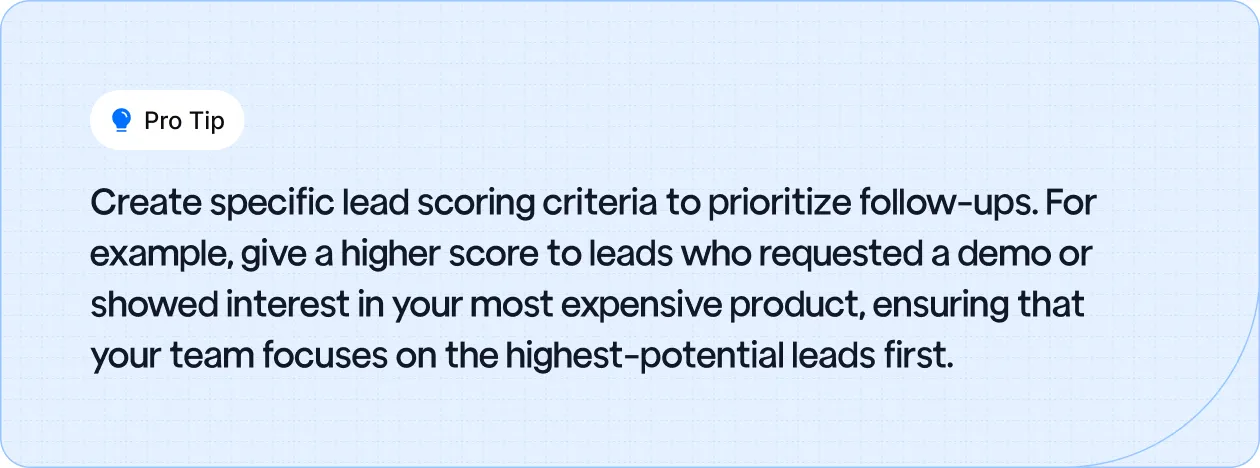
Post-show engagement isn’t just about selling; it’s about building trust. After meeting a lead at a trade show, you need to demonstrate that your company is more than just a vendor; you are a trusted advisor.
Why Educational Content Works?
68% of B2B buyers say they prefer to research a solution on their own before making a decision.
Providing valuable content helps position your brand as an expert, making it easier for leads to trust you and move forward with your solution.
Hosting post-show webinars is a great way to engage with leads who showed interest but need more information before making a decision.
Offer a webinar that dives deep into solving the problem you discussed at the event. This will solidify your credibility.
Follow-up doesn’t end with a single email. You need to consistently engage your leads with relevant content that keeps your brand top-of-mind.
Why It Works?
Consistent communication through valuable content increases the chances of turning a lead into a customer.
Social media can be a goldmine for staying connected with your trade show leads. Engaging on platforms like LinkedIn or Twitter can help nurture relationships and remind leads of your presence.
Why It Works?
Social media extends the conversation and can reinforce your brand’s value over time.

Not all leads are ready to buy right away. By segmenting your leads, you can tailor your messages more effectively, increasing the chances of conversion.
Why It Works?
Tailored messaging speaks directly to a lead’s current needs, improving engagement and conversion rates.
For existing clients, an email might look like:
Subject: Unlock New Benefits with [Your Product/Service]
Hi [Name],
I hope you're enjoying your [current product/service]. We’ve recently introduced [new feature], and I think it could really streamline your processes. Let me know if you'd like to set up a demo!
Best regards,
[Your Name]
Your event generated tons of content, don’t let it go to waste. Repurpose photos, videos, interviews, and product demos into engaging follow-up materials that can continue the conversation long after the event ends.
Why Repurposing Works?
Repurposing content gives you more touchpoints with your leads. It ensures your brand stays top-of-mind while adding value to your leads' decision-making process.
Pro Tip: A well-crafted highlight reel can increase your brand’s visibility by reminding attendees of their interaction with your booth. This extra touchpoint can bring them back into your sales funnel.
How do you know if your post-show efforts are working? The answer lies in tracking the right metrics. Measuring ROI is crucial to understanding whether your follow-up strategies are successful.
By focusing on key performance indicators (KPIs) like lead conversion rates, email open rates, and content engagement, you can get clear insights into what’s driving results and what needs improvement.

Post-show evaluations are key to refining your strategies for the next event. Gathering feedback from your team and leads allows you to understand what worked, what didn’t, and what could be improved.
This invaluable insight helps shape your future trade show participation and follow-up tactics.

Pro Tip: Incorporating feedback into your next strategy will not only improve future shows but also boost your credibility with leads who will appreciate your efforts to continually improve.
Your post-show marketing shouldn’t end in a week. In fact, the best manufacturers understand that the real work happens over the next three months.
Planning long-term engagement ensures that your leads remain nurtured and interested, guiding them steadily towards conversion.
Consistent, thoughtful communication keeps your brand relevant and top-of-mind for prospects.

Pro Tip: Email drip campaigns are essential for nurturing cold leads over time. By sending relevant content at the right intervals, you can keep your leads engaged without overwhelming them.
Company: Telaeris Inc.Industry: Emergency Management Systems
Challenge: Converting trade show leads into long-term clients
Solution: Automated follow-up system using Drip email marketing platform
Outcome: Increased qualified sales opportunities and more deals signed with less effort
Steps Taken:
Results:
Your trade show efforts don't have to end when the event does. By implementing the right post-show marketing strategies, you can transform initial leads into long-term customers.
Follow up quickly, personalize your outreach, leverage CRM tools, provide educational content, and stay engaged with targeted communications, all of which will keep your brand top-of-mind.
Segmenting leads, repurposing event content, and tracking your ROI will help you refine your approach and improve future trade show results.
Q1. Why is follow-up speed so crucial after a trade show?
A1. Follow-up speed is crucial because the longer you wait to reach out, the more likely your leads will forget your brand. Sending a follow-up within the first 24-48 hours helps maintain the excitement and keeps your company fresh in the minds of attendees. Quick, personalized communication increases the chances of converting leads into customers.
Q2. How do I prioritize leads after a trade show?
A2. Prioritizing leads requires segmenting them based on their engagement level. Hot leads who expressed immediate interest should be followed up with first. Warm leads who showed potential interest can be nurtured through targeted content. Cold leads should receive educational follow-ups to reignite their interest. Using CRM tools can help automate and track these priorities efficiently.
Q3. What content should I send to leads after a trade show?
A3. Post-show content should focus on educating leads and building trust. Consider sending case studies, whitepapers, blog posts, and webinars that address the specific pain points of your leads. Repurposing event content, like product demos or interviews, can also serve as engaging follow-up materials. The key is to keep your content relevant and valuable to each lead's needs.
Q4. How do I track the success of my post-show marketing efforts?
A4. Tracking the success of your post-show marketing requires measuring key metrics like lead conversion rate, email open rates, and social media engagement. Use CRM tools to monitor lead behavior and sales pipeline movement. Evaluating ROI will help you understand how effectively your post-show efforts are converting leads into long-term clients.
Q5. How often should I follow up with leads after a trade show?
A5. Your follow-up strategy should include multiple touchpoints over a few months. After the initial follow-up within 24-48 hours, send targeted emails and content at regular intervals. Email drip campaigns can help maintain engagement, especially for cold leads. Consistent but non-intrusive follow-ups help keep your brand top-of-mind without overwhelming prospects.
Q6. Can social media help with post-show engagement?
A6. Yes, social media is a great tool for keeping the conversation going after a trade show. Share event highlights, interviews, behind-the-scenes content, and engage directly with attendees. Use platforms like LinkedIn, Twitter, and Instagram to maintain visibility and encourage further interaction. Creating a branded hashtag can also help expand your reach as attendees share content.
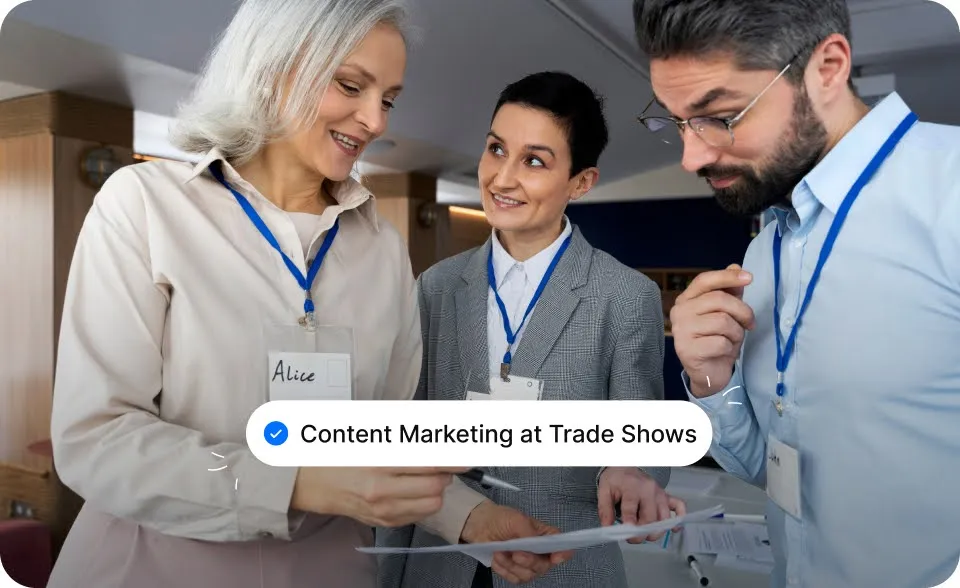
You’ve invested heavily in your trade show booth, every detail is perfect. But here’s the thing: without leveraging content marketing at trade shows, all that effort might not pay off as well as it should.
You’re not just up against other exhibitors; you’re competing for the attention of an audience flooded with information. So, what happens? Your message often gets lost, and the leads you generate are less qualified than you hoped for.
The frustrating part? You’ve got the product, but without the right content strategy, you’re missing a huge opportunity to engage potential buyers before, during, and after the show. Instead of relying solely on face-to-face interactions, you can use content to build buzz pre-show, provide real-time value during the event, and nurture those leads well after the booth has been packed up.
This guide is here to help you do just that, turn your trade show efforts into lasting, profitable relationships.

Before the trade show even starts, you need to get your audience excited and ready. Pre-show content sets the tone for what's to come, making sure your booth is on their radar well before they step foot in the event hall.
Start generating buzz early with teasers and sneak peeks. Creating anticipation for your booth ensures that visitors are eager to check out what you’re offering. You want them to know exactly why they need to stop by.
Example: Brand X used LinkedIn to share a countdown and preview of their new product, resulting in higher foot traffic and more qualified leads.
Collaborating with other exhibitors or industry influencers can significantly extend the reach of your pre-show content. These partnerships create a network effect that amplifies your message and sparks curiosity among attendees.
Use email and social media to engage potential leads before the show begins. Start the conversation early to keep your audience interested and excited about what your booth will offer.

Now that you’ve got your audience’s attention, it’s time to keep them engaged throughout the event. Using dynamic and relevant content during the show will leave a lasting impression and turn interest into real connections.
Interactive content encourages deeper engagement. By involving your audience in hands-on experiences, you're making sure they don’t just walk by, they stop and participate.

While the show is happening, keep your online audience in the loop with live updates. Share what’s happening at your booth, creating a sense of urgency for those who haven’t stopped by yet.
Each attendee has a different need or interest. Personalizing your content helps ensure you’re offering value to everyone who stops by.

Once you’ve captured attention, it’s time to turn that engagement into qualified leads. Offering valuable content that solves real problems will motivate visitors to exchange their contact details for more in-depth resources.
Don’t just give away content, make it something your leads want. Offer high-value resources in exchange for contact details to build your lead database.
Interactive content is not only great for engagement, it’s also an excellent way to qualify leads. Use assessments or quizzes to gauge interest and collect information on potential buyers.

The work doesn’t end when the event does. Post-show content helps you maintain momentum, turning your trade show success into long-term relationships and continued engagement.
Maximize the value of your content by repurposing it. Whether it’s videos, social posts, or event highlights, your trade show content can continue driving engagement long after the show ends.
Example: Brand Y created a blog post summarizing key takeaways from their event presentations, keeping the conversation going for months.
Now that you’ve gathered all those leads, it’s time to nurture them with automated follow-up sequences. This will ensure that you stay in touch and continue building relationships.

Content marketing doesn’t stop at the event. By aligning your content with the buyer’s journey, you can continue nurturing leads and guiding them toward a purchase decision, ensuring a constant flow of qualified prospects.
Your content strategy should evolve as your leads do. Align your content with the stages of the buyer’s journey, awareness, consideration, and decision-making, to ensure you’re addressing their needs at each stage.
Personalized content leads to higher engagement. Tailor your content to each lead’s position in the sales funnel to ensure they receive the most relevant messages.

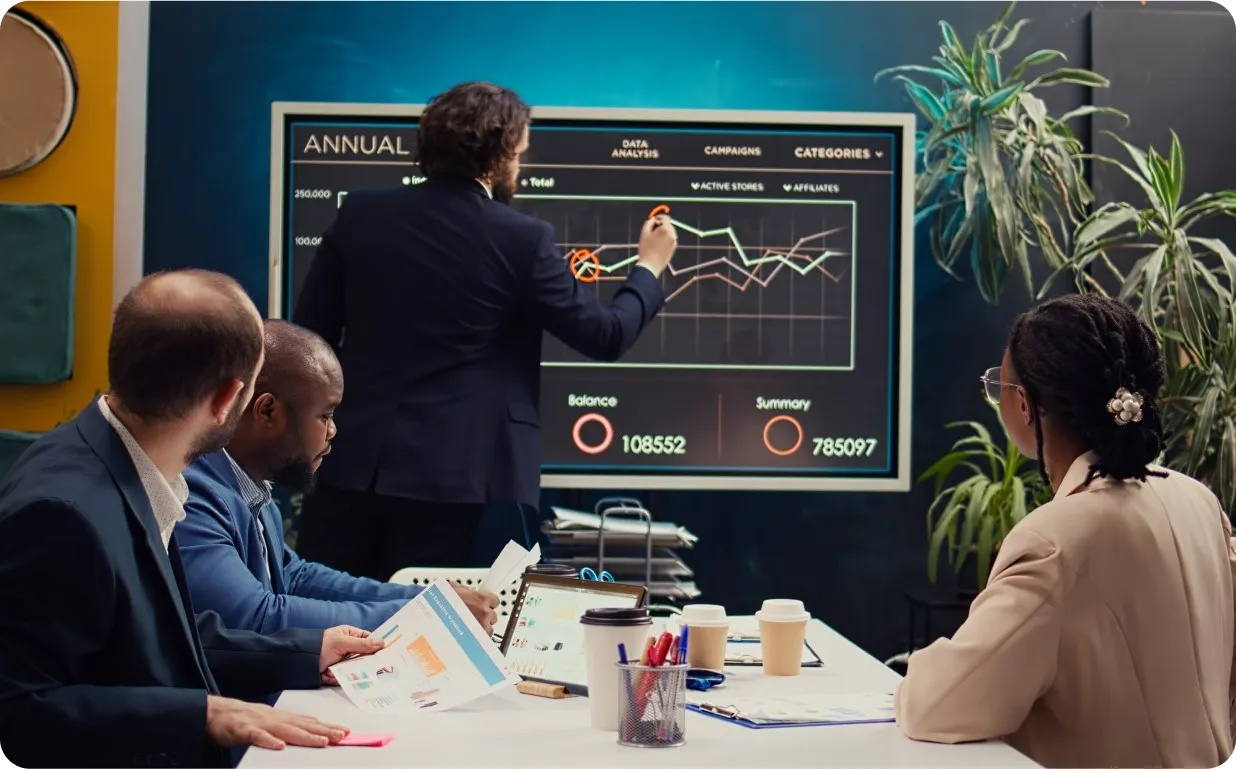
To truly maximize ROI, you need to track how your content is performing. By analyzing results and refining your approach, you can ensure better performance at future trade shows.
Track how your content performs during and after the show. Key metrics such as content views, lead conversions, and social media engagement will provide insights into what works and what doesn’t.
Use analytics tools to identify which content pieces performed best. This will help you optimize your content strategy for better results at future trade shows.
Don’t limit yourself to just one channel. By using email, social media, and your website, you ensure that your content reaches as many potential leads as possible.
Leverage videos to engage your audience. With higher engagement rates, videos can significantly boost interest in your booth and product offerings.

Content marketing at trade shows is about more than just drawing attention during the event. It’s a strategic tool for generating high-quality leads, building long-term relationships, and boosting your ROI.
By utilizing content marketing, you’re not just hoping for a successful event, you’re actively shaping an ongoing relationship with your leads. Content drives more than foot traffic to your booth; it builds lasting connections that fuel future business opportunities.
The impact of an effective content strategy stretches well beyond the event itself. It builds a foundation for nurturing leads, keeping the conversation alive, and guiding prospects through their buyer’s journey.
A well-executed strategy not only delivers short-term results but also fosters continuous engagement, which keeps your brand top-of-mind for future opportunities.
Q1: How can content marketing help manufacturers stand out at trade shows?
A1: Content marketing allows manufacturers to generate buzz and engage attendees before the event even starts. By using targeted teasers, pre-show content, and tailored messaging, you can attract the right audience to your booth and set the stage for meaningful conversations.
Q2: What types of content should I create for trade shows to drive the most leads?
A2: Focus on high-value content like whitepapers, case studies, and exclusive demos. These resources help establish authority and provide solutions to potential customers' pain points. Interactive content like quizzes or assessments can also qualify leads on the spot.
Q3: How do I engage attendees during a trade show using content marketing?
A3: Utilize live demos, interactive content, and social media updates to keep your audience engaged. Tailoring your content to each visitor’s needs and providing instant value through personalized demos or content will leave a lasting impression.
Q4: What role does social media play in content marketing at trade shows?
A4: Social media is essential for sharing real-time updates from your booth, showcasing product demos, and engaging with both onsite and remote audiences. Using event-specific hashtags and live posts can generate additional buzz and attract more visitors to your booth.
Q5: How can I convert engagement at trade shows into long-term leads?
A5: Offer lead magnets like exclusive content or special offers in exchange for attendee information. Use automated follow-up emails and personalized content to nurture these leads, ensuring continued engagement long after the event.
Q6: What are the key metrics to track for measuring the success of content marketing at trade shows?
A6: Track metrics like lead conversions, social media engagement, and content views. Analyzing these will help determine which content strategies were most effective, allowing you to refine future content and optimize for better results.
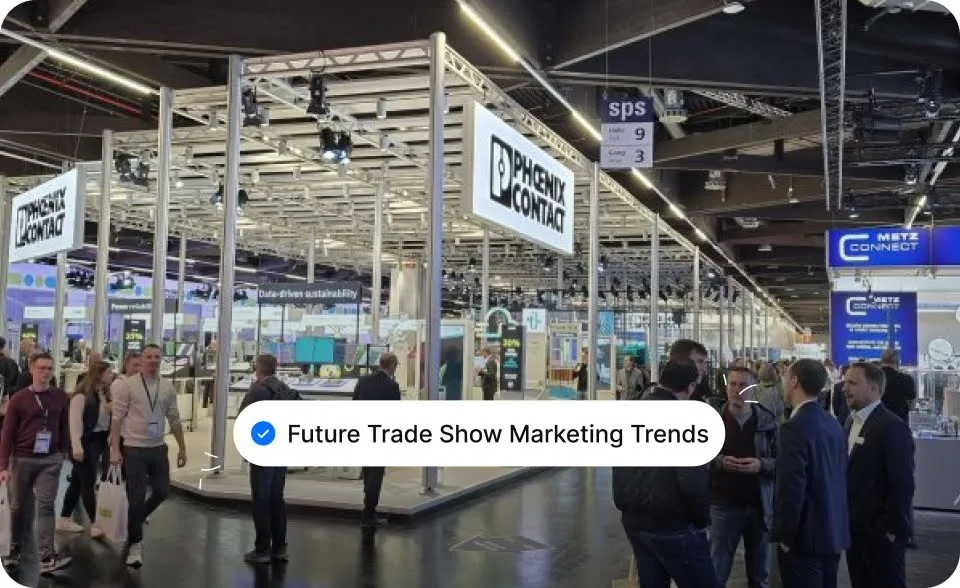
You're a manufacturer who just spent thousands on a trade show booth, but you're still worried. Is that flashy display really translating into high-quality leads? Are you showing off your product’s full capability, or are attendees just seeing a static piece of machinery they could have viewed online?
The truth is, the old trade show playbook of product catalogs and branded stress balls isn't working anymore.
Your most forward-thinking competitors are already using augmented reality to let buyers virtually inspect a complex hydraulic system, collecting real-time attendee data to personalize every conversation, and extending their reach with hybrid events.
They aren’t just hoping for foot traffic; they’re engineering a predictable return on their investment.
This article isn't about minor tweaks. It’s for manufacturers who are ready to stop playing defense and start leveraging the innovations that will transform their trade show presence from an expense into a powerful growth engine.
Trade shows are evolving past the traditional booth setup. In the future, manufacturers will need to move away from static displays and adopt interactive, immersive experiences that captivate and engage.
Think beyond brochures and branded swag, today’s attendees want experiences that blend innovation with personalization. By incorporating AR/VR technology and AI-powered interactions, your booth can offer a more dynamic and memorable experience.

These innovations are designed not just to showcase your product, but to make your audience feel as if they’re a part of the process.
Key Innovations for Manufacturers:

The rise of hybrid trade shows marks a permanent shift in how manufacturers approach events. With both in-person and virtual attendees, hybrid events enable manufacturers to expand their reach and engagement.
This dual approach allows you to interact with a larger, more diverse audience, breaking down geographical barriers and offering access to a broader pool of prospects.

It’s no longer enough to focus on just one format; manufacturers must be ready to leverage both physical and digital spaces effectively.
How Hybrid Events Benefit Manufacturers:

Gone are the days of relying on foot traffic numbers as the sole measure of trade show success. In the future, data will be the cornerstone of meaningful trade show marketing.
Real-time tracking tools allow manufacturers to capture high-quality leads, measure engagement, and optimize their strategy during the event.
Companies that embrace advanced analytics report 5-8% higher marketing ROI than their competitors.
This shift to data-driven marketing means manufacturers can tailor their approach in real-time, improving ROI and ensuring that no opportunity is missed.
Data Tools for Manufacturers:

Sustainability is no longer a trend; it’s a critical part of trade show success. As the industry moves toward greener practices, manufacturers must lead the way in adopting eco-friendly strategies that reduce waste and showcase their commitment to environmental responsibility.

From sustainable booth designs to paperless marketing, it’s time to rethink how trade shows can contribute to a more sustainable future while still offering maximum engagement.
Sustainable Trade Show Strategies:

Gamification is one of the most effective ways to boost engagement at trade shows.
By incorporating interactive games, challenges, and live demos into your booth, you can capture the attention of attendees and create memorable experiences that last well beyond the event.
Engaging attendees through fun, competition, and rewards keeps them interested, encourages longer visits, and increases the likelihood of lead capture.
Interactive Engagement for Manufacturers:
As trade shows become more competitive, personalization will be the differentiator that drives success. Attendees expect tailored experiences that align with their needs and interests.
By using data and AI-powered tools, manufacturers can provide personalized content, product demos, and VIP experiences that resonate with each attendee.
Customizing the attendee journey not only increases engagement but also strengthens your brand’s relationship with prospects.
Personalization Strategies:

Influencers are no longer reserved for social media; they have become powerful allies in boosting trade show presence and brand credibility.
By collaborating with the right influencers, manufacturers can significantly expand their reach, build trust, and drive more engagement at trade shows.
Whether it’s through live coverage or post-event promotion, influencers can help your brand stand out and capture the attention of a wider audience.
Influencer Strategies for Manufacturers:

The landscape of trade show marketing is shifting, and manufacturers must evolve or risk being left behind.
From hybrid events that connect global audiences to immersive experiences that captivate attention, the future demands more than just a booth.
It requires a bold, data-driven strategy that maximizes engagement and ROI.
The old ways of doing things simply won’t work anymore, true success lies in embracing the next wave of innovation.
Q1. What are the main trends shaping the future of trade show marketing for manufacturers?
A1. The future of trade show marketing for manufacturers is driven by immersive booth experiences, hybrid events that combine in-person and virtual attendance, and data-driven strategies. Manufacturers need to embrace AR/VR technology, personalized interactions, and sustainability to stay competitive.
Q2. How can manufacturers make their trade show booths more engaging?
A2. Manufacturers can make their booths more engaging by incorporating AR/VR experiences, interactive displays, and gamified challenges. These elements create an immersive, personalized experience that keeps attendees interested and enhances brand recall.
Q3. Why are hybrid trade shows important for manufacturers?
A3. Hybrid trade shows allow manufacturers to reach a wider, global audience by combining in-person and virtual elements. This approach helps extend reach, engage remote attendees, and provides post-event opportunities to continue the conversation and drive ROI.
Q4. How can data help improve trade show marketing ROI?
A4. Data helps manufacturers track attendee engagement, capture high-quality leads, and adjust strategies in real-time. With tools for lead scoring, engagement metrics, and post-event insights, manufacturers can measure and optimize their ROI effectively.
Q5. What sustainability practices should manufacturers adopt for trade shows?
A5. Manufacturers should adopt eco-friendly booth designs, paperless marketing strategies, and carbon offset initiatives. These efforts not only reduce waste but also align with the growing demand for environmentally responsible practices, making your brand more appealing to conscious attendees.
Q6. How can influencers enhance trade show marketing for manufacturers?
A6. Influencers can amplify a manufacturer’s trade show presence by hosting demos, sharing product insights, and creating live content during events. Partnering with influencers whose audience matches your target market can significantly boost visibility and credibility.





.svg)
.svg)
.svg)